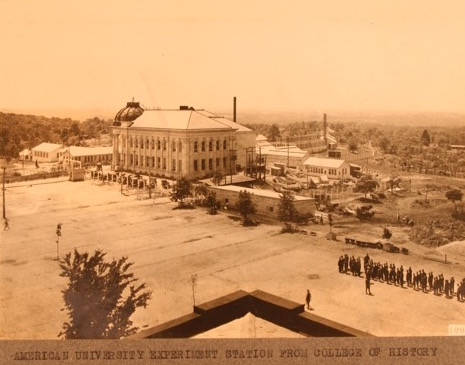 West-facing view of the American University Experiment Station, from the roof of the College of History building at American University. McKinley Hall, at center, was the main chemistry laboratory for the Bureau of Mines' research division and, later, the newly organized U.S. Chemical Warfare Service. (National Archives, photo no. 70-CW-2)
West-facing view of the American University Experiment Station, from the roof of the College of History building at American University. McKinley Hall, at center, was the main chemistry laboratory for the Bureau of Mines' research division and, later, the newly organized U.S. Chemical Warfare Service. (National Archives, photo no. 70-CW-2)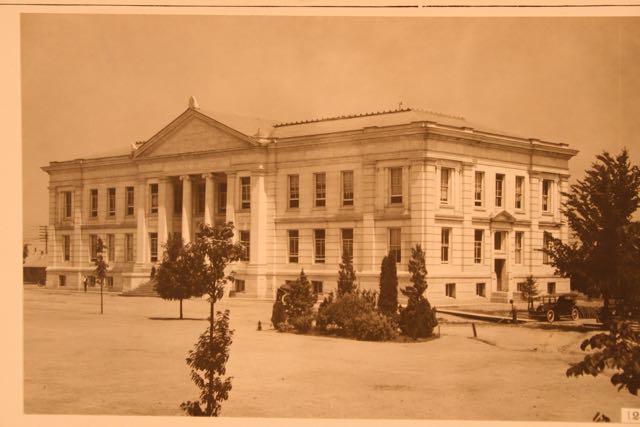 The College of History building at American University, which the Bureau of Mines shared with the Corps of Engineers during the war. (National Archives, photo no. 111-SC-55275)
The College of History building at American University, which the Bureau of Mines shared with the Corps of Engineers during the war. (National Archives, photo no. 111-SC-55275)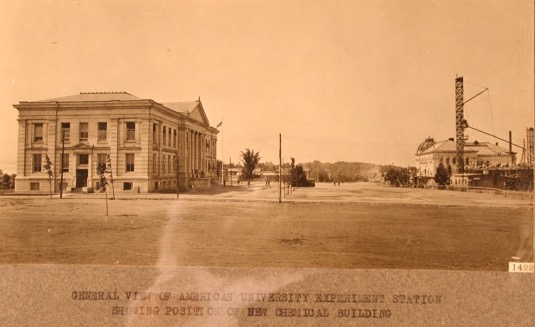 A view of the American University quad, with the College of History on the left and the partially constructed chemistry laboratory on the right, with McKinley Hall behind. Photograph probably taken in summer or fall of 1918. (National Archives, photo no. 70-CW-1)
A view of the American University quad, with the College of History on the left and the partially constructed chemistry laboratory on the right, with McKinley Hall behind. Photograph probably taken in summer or fall of 1918. (National Archives, photo no. 70-CW-1)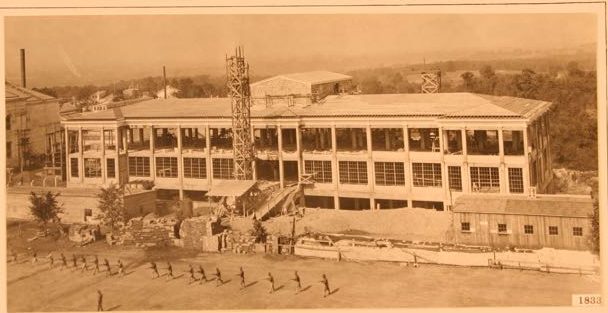 The incomplete chemical laboratory at the American University Experiment Station. Construction began in 1918 but stalled because of massive cost overruns. The lab was unfinished when the war ended, and was turned over to American University. Today the building is known as Mary Graydon Hall. (National Archives, photo no. 111-SC-55273)
The incomplete chemical laboratory at the American University Experiment Station. Construction began in 1918 but stalled because of massive cost overruns. The lab was unfinished when the war ended, and was turned over to American University. Today the building is known as Mary Graydon Hall. (National Archives, photo no. 111-SC-55273)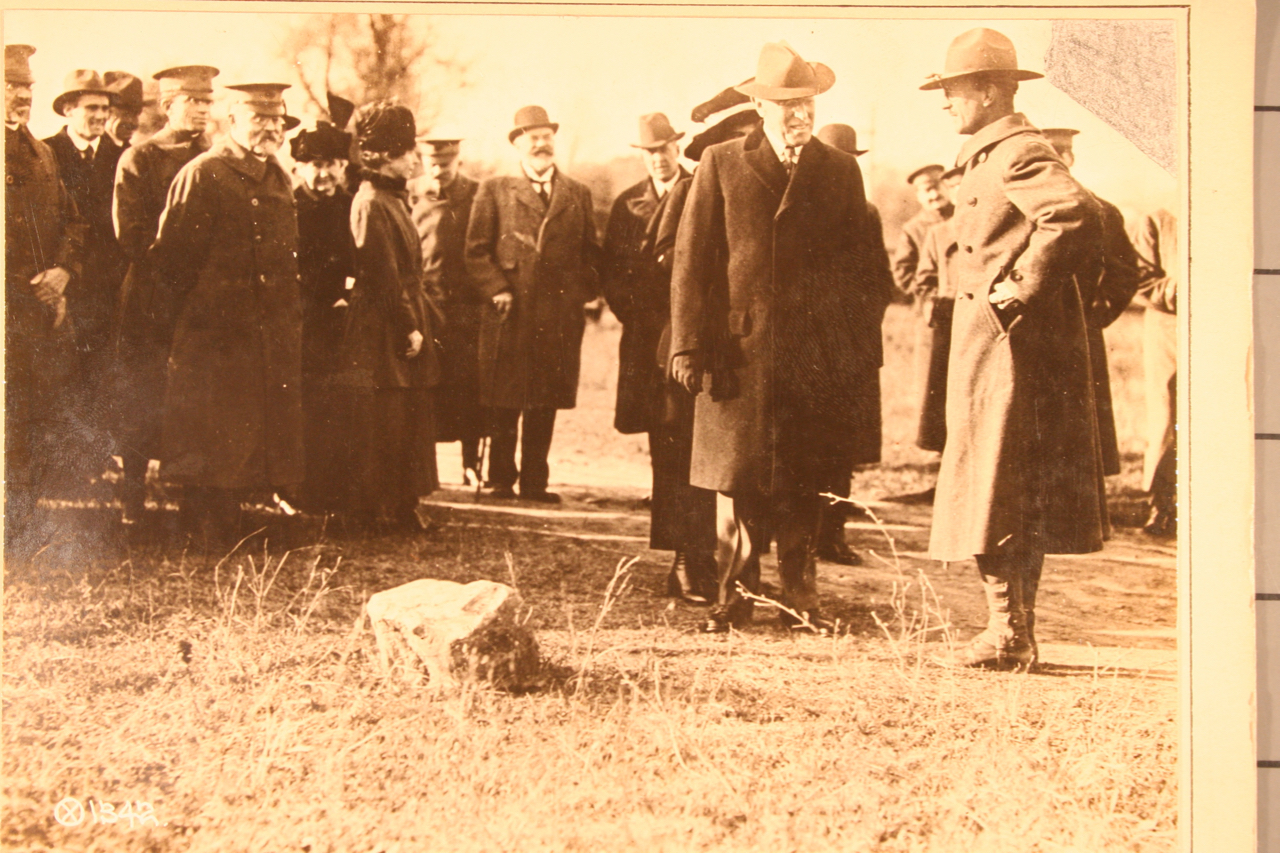 President Wilson visits Camp American University in November 1917 to see the work of the 24 Engineers, a camouflage unit. The rock at Wilson's feet was a hidden listening post. After Wilson was asked to try to spot the eavesdropping post nearby, the soldier flipped over the rock and emerged, startling the president. National Archives, photo no. 111-SC-1342)
President Wilson visits Camp American University in November 1917 to see the work of the 24 Engineers, a camouflage unit. The rock at Wilson's feet was a hidden listening post. After Wilson was asked to try to spot the eavesdropping post nearby, the soldier flipped over the rock and emerged, startling the president. National Archives, photo no. 111-SC-1342)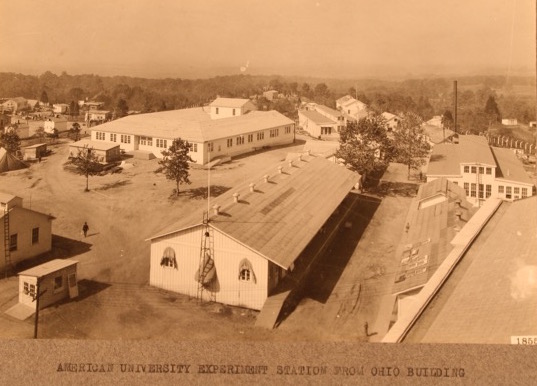 West-facing view of the American University Experiment Station from the top of McKinley Hall. (National Archives, photo no. 70-CW-5)
West-facing view of the American University Experiment Station from the top of McKinley Hall. (National Archives, photo no. 70-CW-5)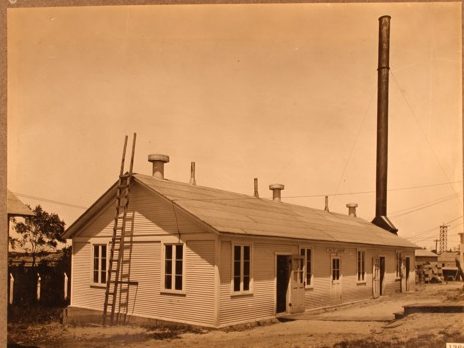 The man test house at American University Experiment Station where soldiers tested out new masks and canister designs. (National Archives, photo no. 70-CW-6)
The man test house at American University Experiment Station where soldiers tested out new masks and canister designs. (National Archives, photo no. 70-CW-6)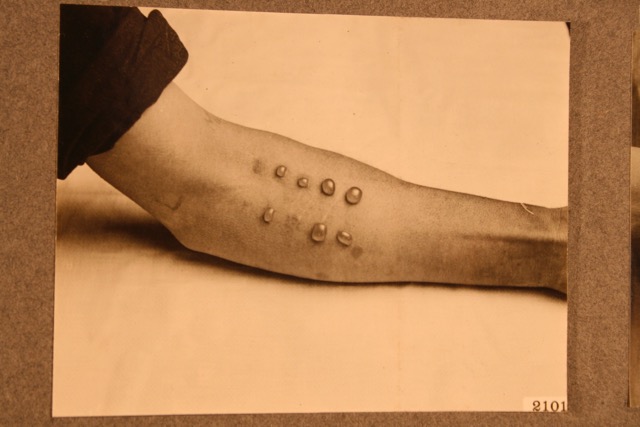 Example of skin test comparing different chemical weapons agents illustrated comparison of mustard gas and lewisite blisters. Right photo showed blisters in test of protective salves. (National Archives, photo no. 70-CW-100)
Example of skin test comparing different chemical weapons agents illustrated comparison of mustard gas and lewisite blisters. Right photo showed blisters in test of protective salves. (National Archives, photo no. 70-CW-100)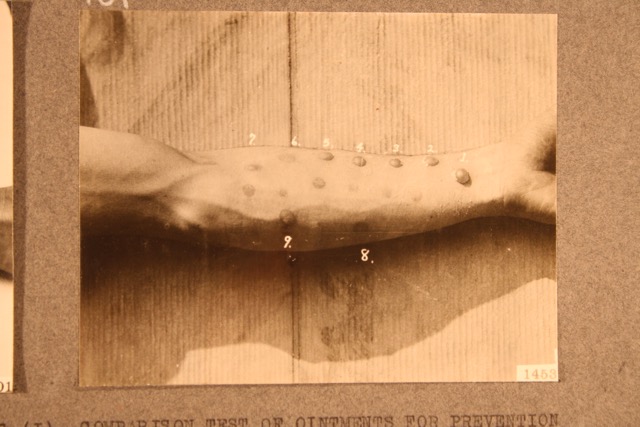 Photo of blisters in test of protective salves. (National Archives, photo no. 70-CW-101)
Photo of blisters in test of protective salves. (National Archives, photo no. 70-CW-101)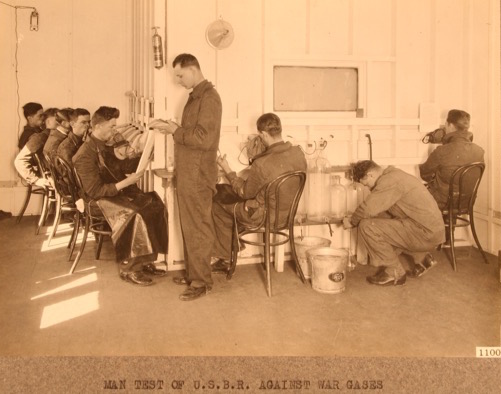 Photo of the inside of the Man Test House, where soldiers carried out trials on new equipment, gases and gear. The soldiers in the photo are testing box respirators against an unidentified war gas. (National Archives, photo no. 70-CW-7)
Photo of the inside of the Man Test House, where soldiers carried out trials on new equipment, gases and gear. The soldiers in the photo are testing box respirators against an unidentified war gas. (National Archives, photo no. 70-CW-7)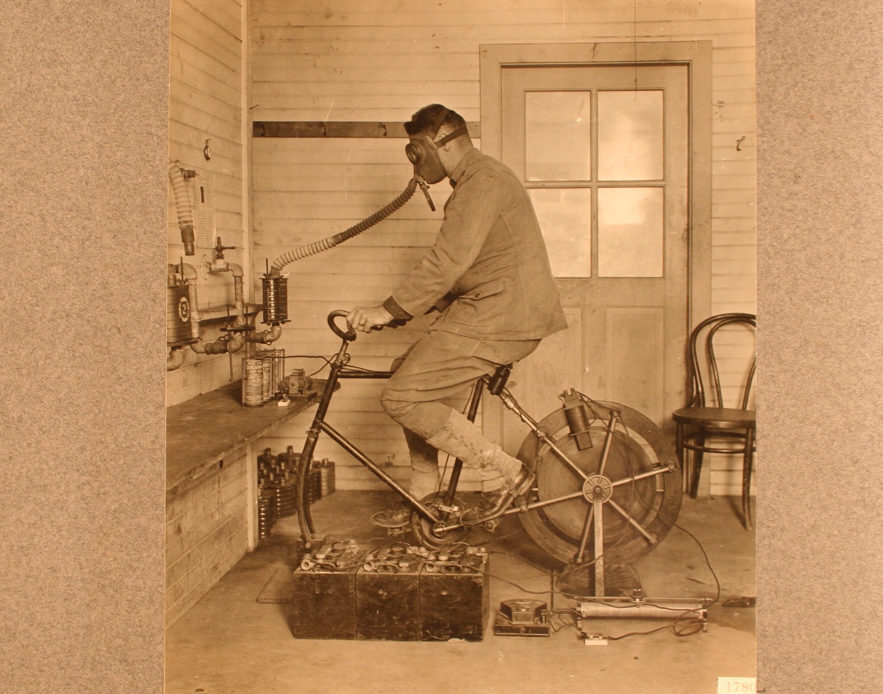 Stationary bicycle in the man test house used to test canisters during physical exertion.(National Archives, photo no. 70-CW-9)
Stationary bicycle in the man test house used to test canisters during physical exertion.(National Archives, photo no. 70-CW-9)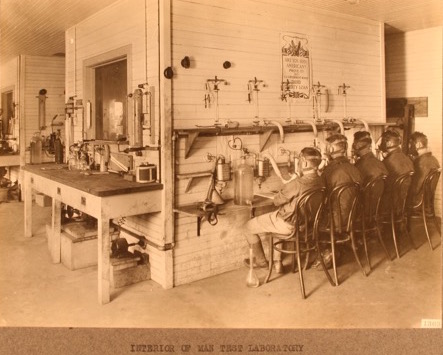 Photo of the inside of the Man Test House, where soldiers carried out trials on new equipment, gases and gear. (National Archives, photo no. 70-CW-7)
Photo of the inside of the Man Test House, where soldiers carried out trials on new equipment, gases and gear. (National Archives, photo no. 70-CW-7)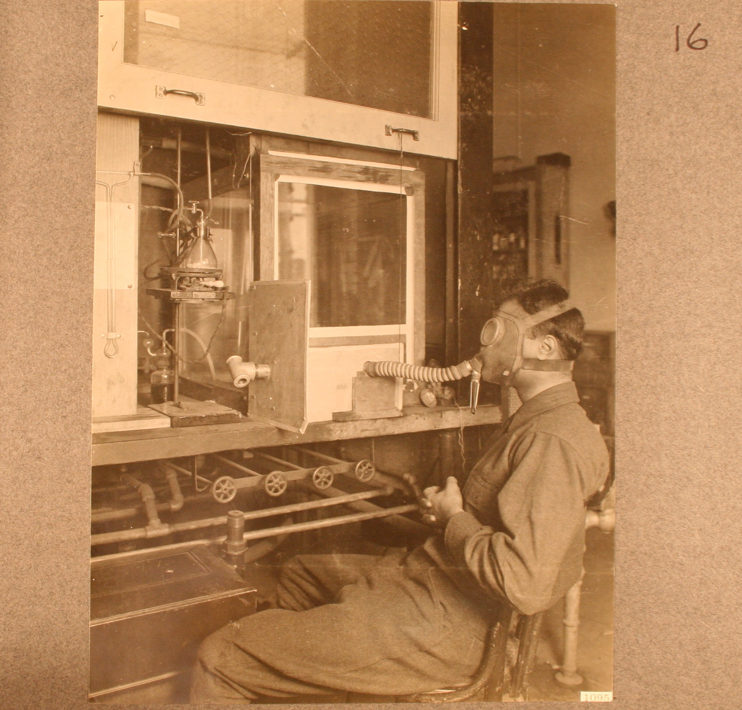 Photo labeled "Physiological test of man against war gases." (National Archives, photo no. 70-CW-16)
Photo labeled "Physiological test of man against war gases." (National Archives, photo no. 70-CW-16)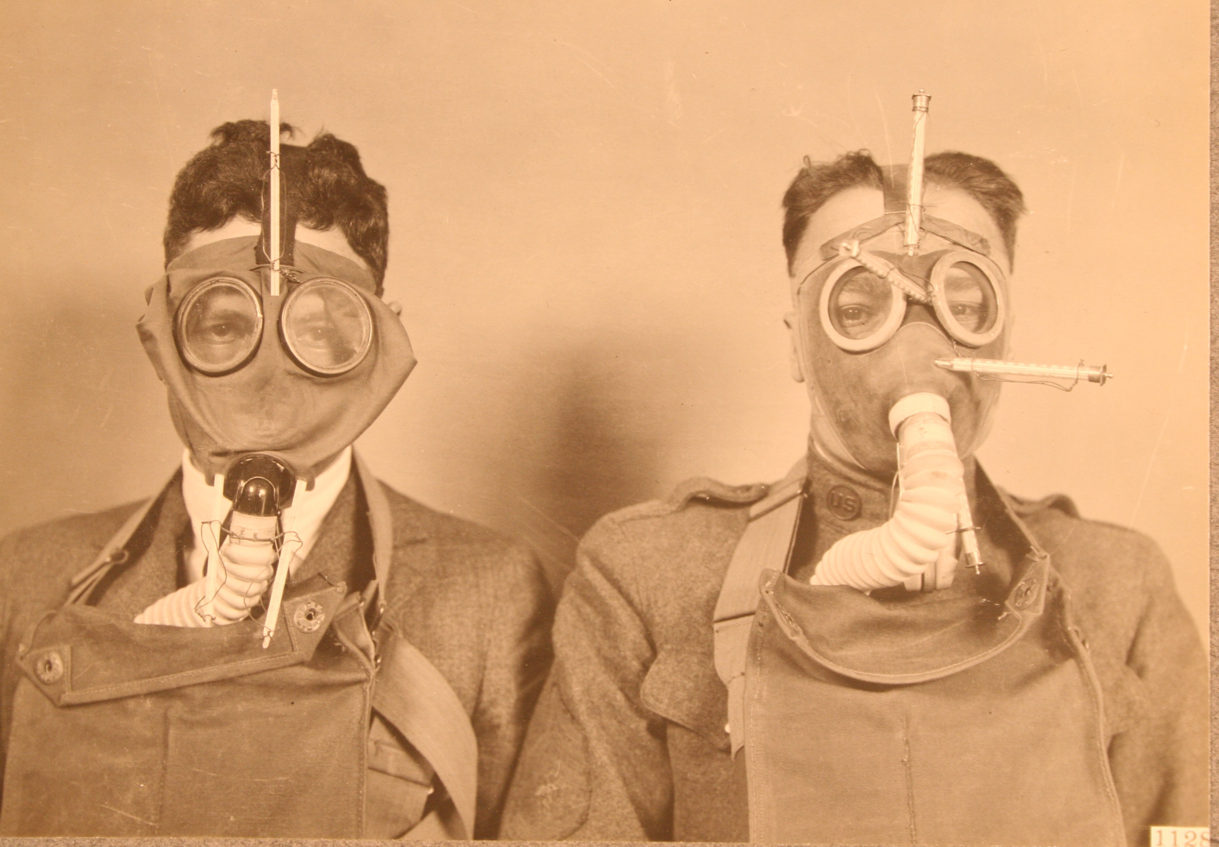 Temperature test for masks. Mask on the left is a British-style box respirator, mask on the right is a French Tissot-style mask. (National Archives, photo no. 70-CW-31)
Temperature test for masks. Mask on the left is a British-style box respirator, mask on the right is a French Tissot-style mask. (National Archives, photo no. 70-CW-31)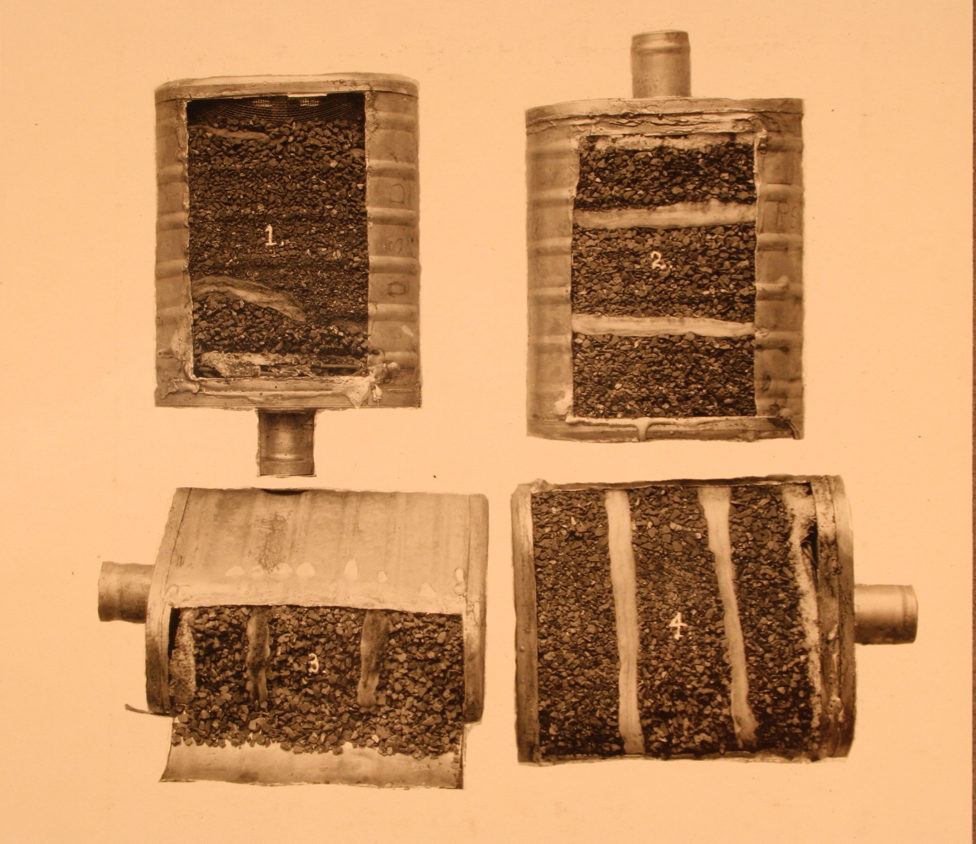 Cutaway view of gas mask canister. (National Archives, photo no. 70-CW-13)
Cutaway view of gas mask canister. (National Archives, photo no. 70-CW-13)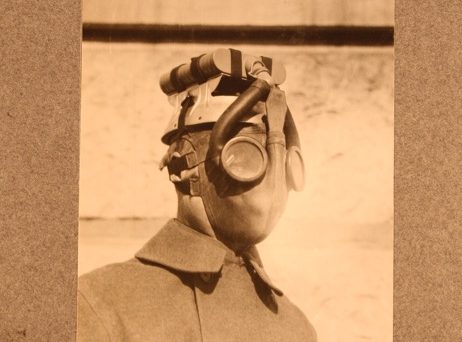 Production model of combination helmet and mask, with canister atop helmet. (National Archives, photo no. 111-SC-54625)
Production model of combination helmet and mask, with canister atop helmet. (National Archives, photo no. 111-SC-54625)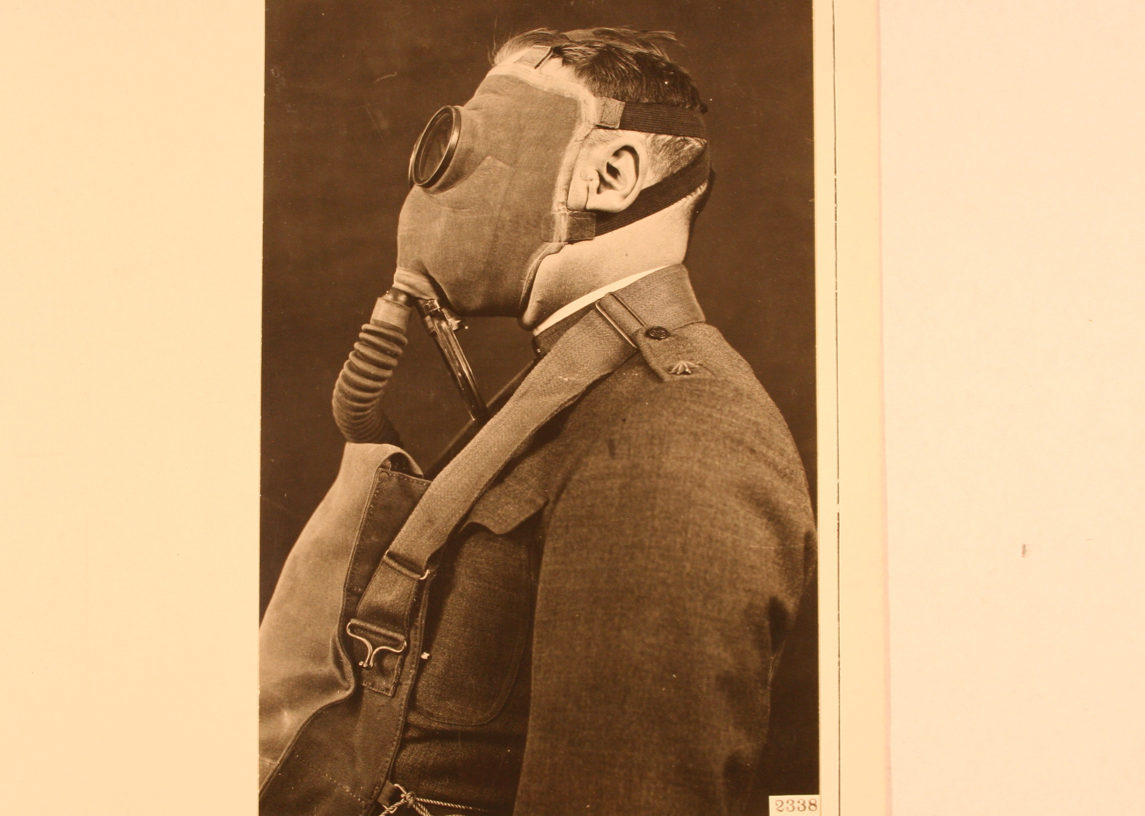 Side view of soldier in Akron Tissot mask, an American redesign of the French Tissot model, which were much more comfortable than the British small box respirators. (National Archives, photo no. 70-CW-29)
Side view of soldier in Akron Tissot mask, an American redesign of the French Tissot model, which were much more comfortable than the British small box respirators. (National Archives, photo no. 70-CW-29)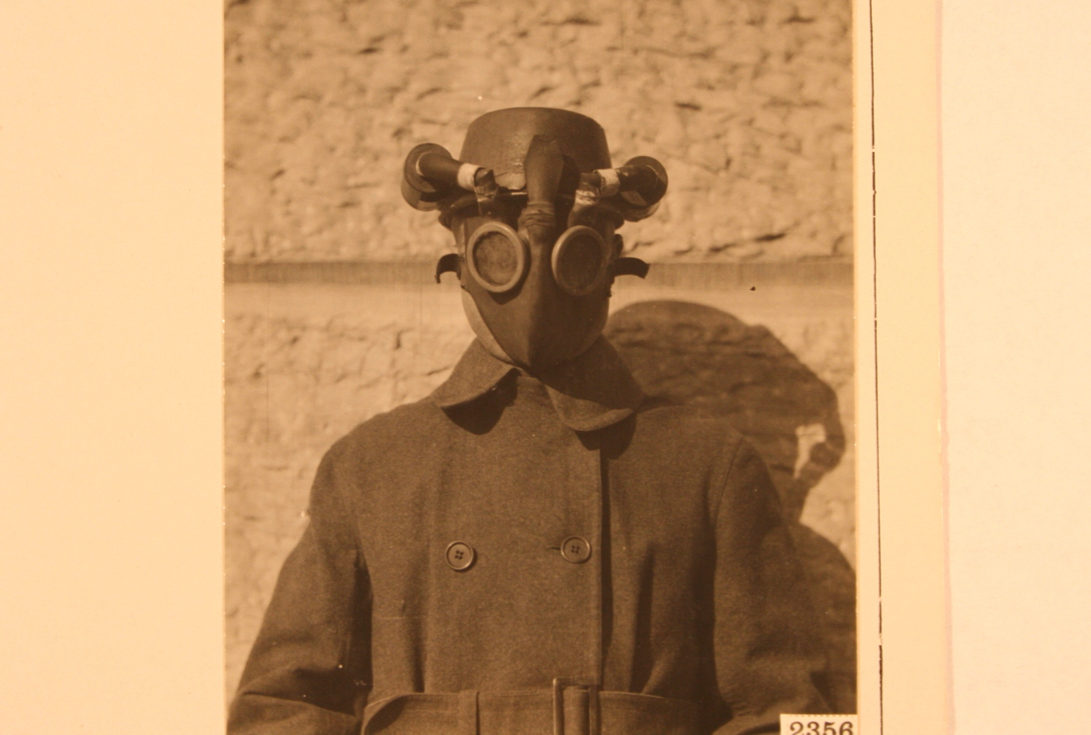 Production model of combination helmet and mask, with two canisters, one on each side of the helmet. (National Archives, photo no. 111-SC-54627)
Production model of combination helmet and mask, with two canisters, one on each side of the helmet. (National Archives, photo no. 111-SC-54627)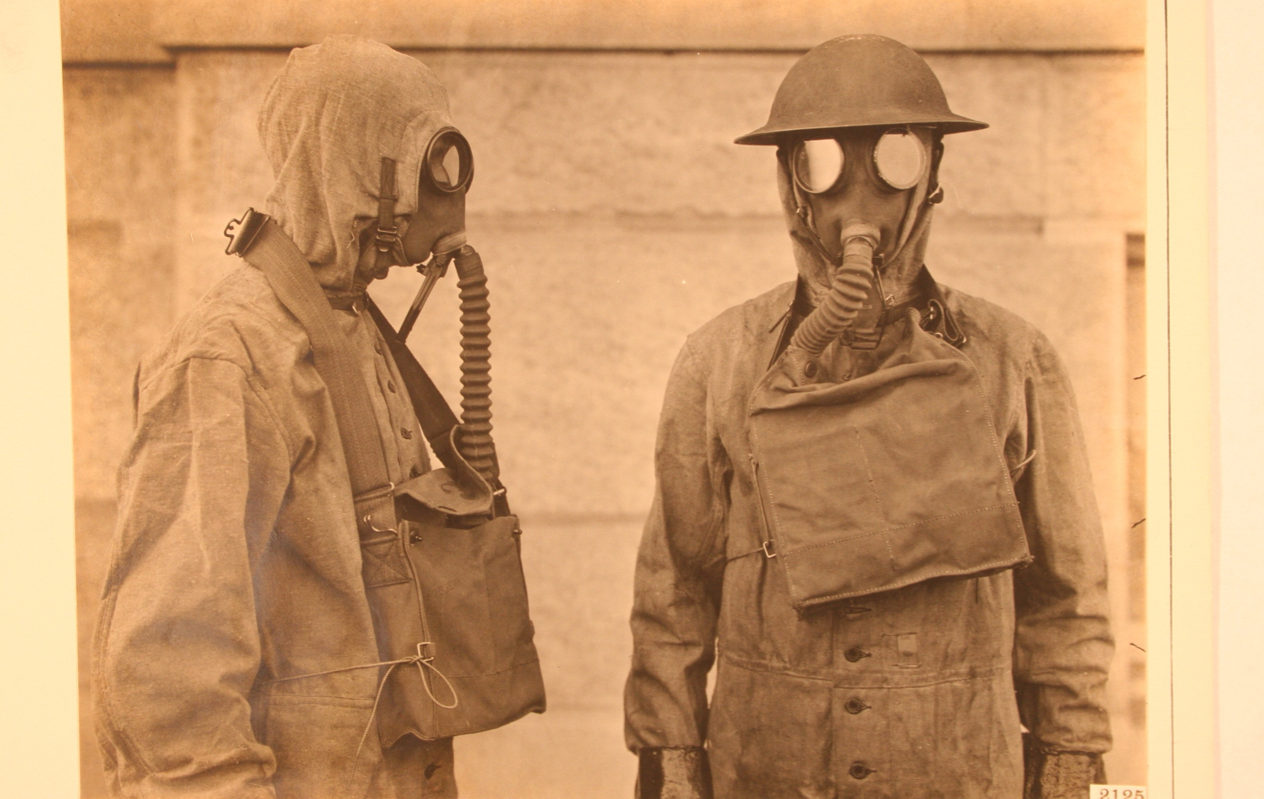 Protective suits. (National Archives, photo no. 111-SC-54546)
Protective suits. (National Archives, photo no. 111-SC-54546)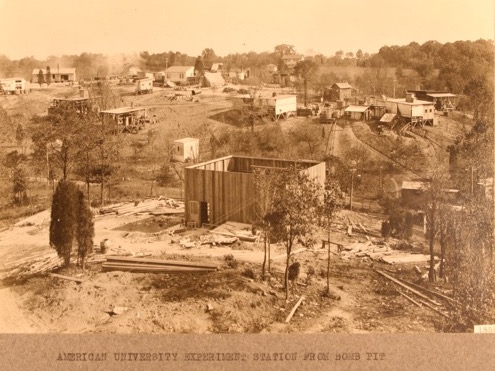 View of some of the many outbuildings of the American University Experiment Station, with bomb pit (under construction) in foreground. (National Archives, photo no. 111-SC-55269)
View of some of the many outbuildings of the American University Experiment Station, with bomb pit (under construction) in foreground. (National Archives, photo no. 111-SC-55269)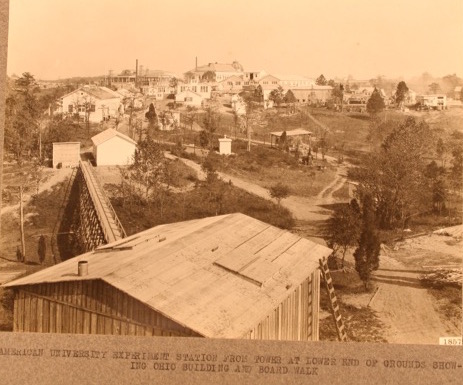 View of the American University Experiment Station from the east, with McKinley Hall in background. (National Archives, photo no. 70-CW-3)
View of the American University Experiment Station from the east, with McKinley Hall in background. (National Archives, photo no. 70-CW-3)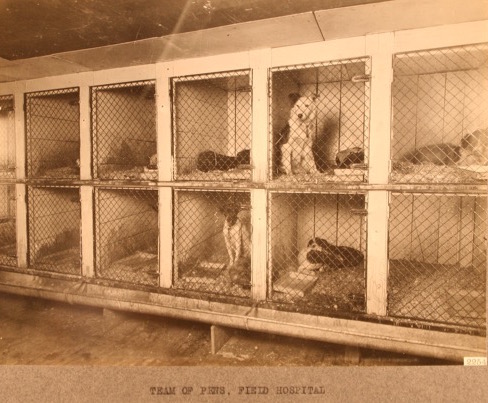 Kennel at the American University Experiment station for dogs used in lab tests. Hundreds of dogs died in experiments of the research division ; mice, cats, goats, monkeys, and other animals were also used in tests. (National Archives, photo no. 70-CW-18)
Kennel at the American University Experiment station for dogs used in lab tests. Hundreds of dogs died in experiments of the research division ; mice, cats, goats, monkeys, and other animals were also used in tests. (National Archives, photo no. 70-CW-18)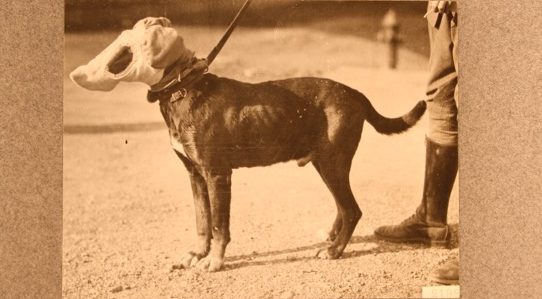 Dog in mask. (National Archives, photo no. 70-CW-42)
Dog in mask. (National Archives, photo no. 70-CW-42)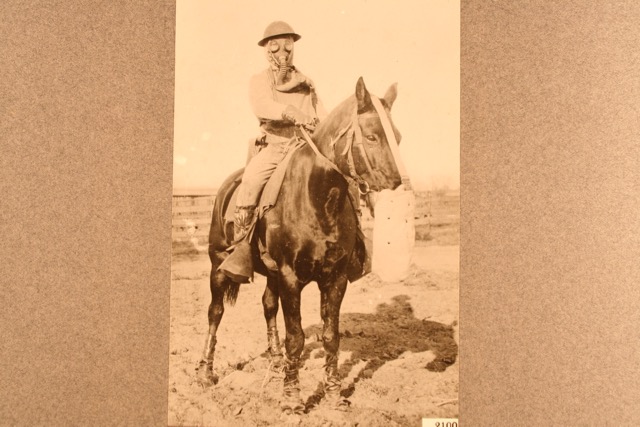 Soldier wearing a mustard gas defense suit astride a horse wearing a gas mask and mustard gas boots to protect the horse's hooves and legs from mustard on the ground. (National Archives, photo no. 111-SC-54542)
Soldier wearing a mustard gas defense suit astride a horse wearing a gas mask and mustard gas boots to protect the horse's hooves and legs from mustard on the ground. (National Archives, photo no. 111-SC-54542)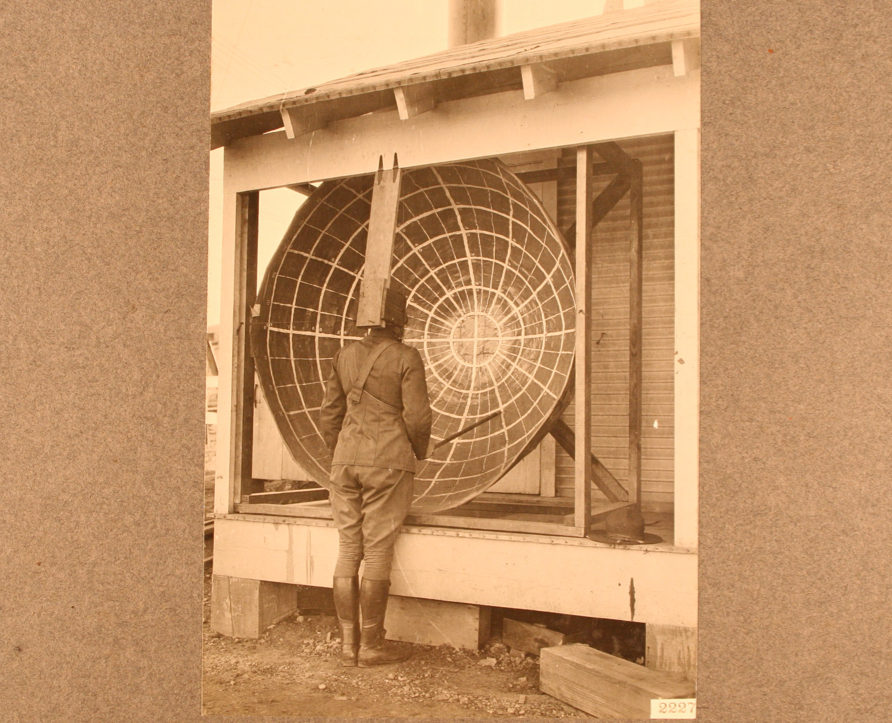 Masked soldier facing vision chart, presumably for determining field of vision for masked soldiers. (National Archives, photo no. 70-CW-12)
Masked soldier facing vision chart, presumably for determining field of vision for masked soldiers. (National Archives, photo no. 70-CW-12)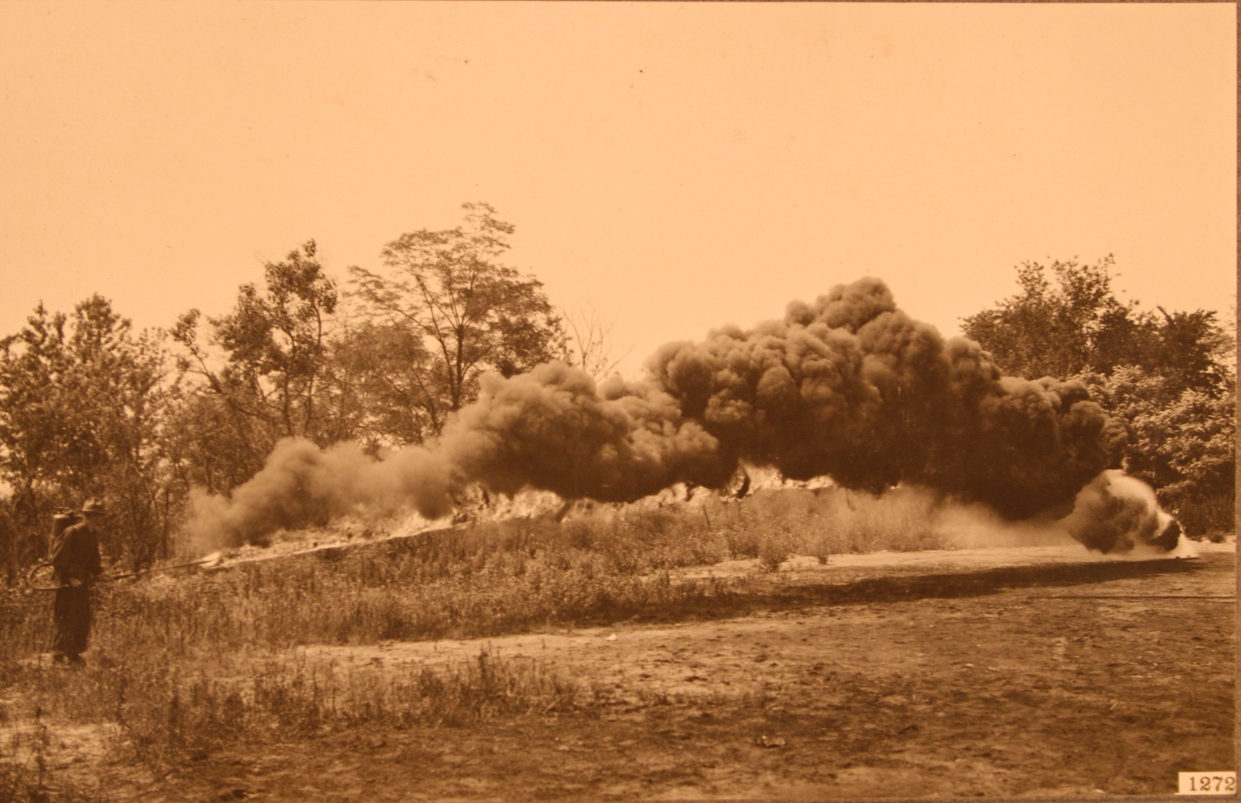 Flame thrower demonstration at American University Experiment Station. (National Archives, photo no. 70-CW-56)
Flame thrower demonstration at American University Experiment Station. (National Archives, photo no. 70-CW-56)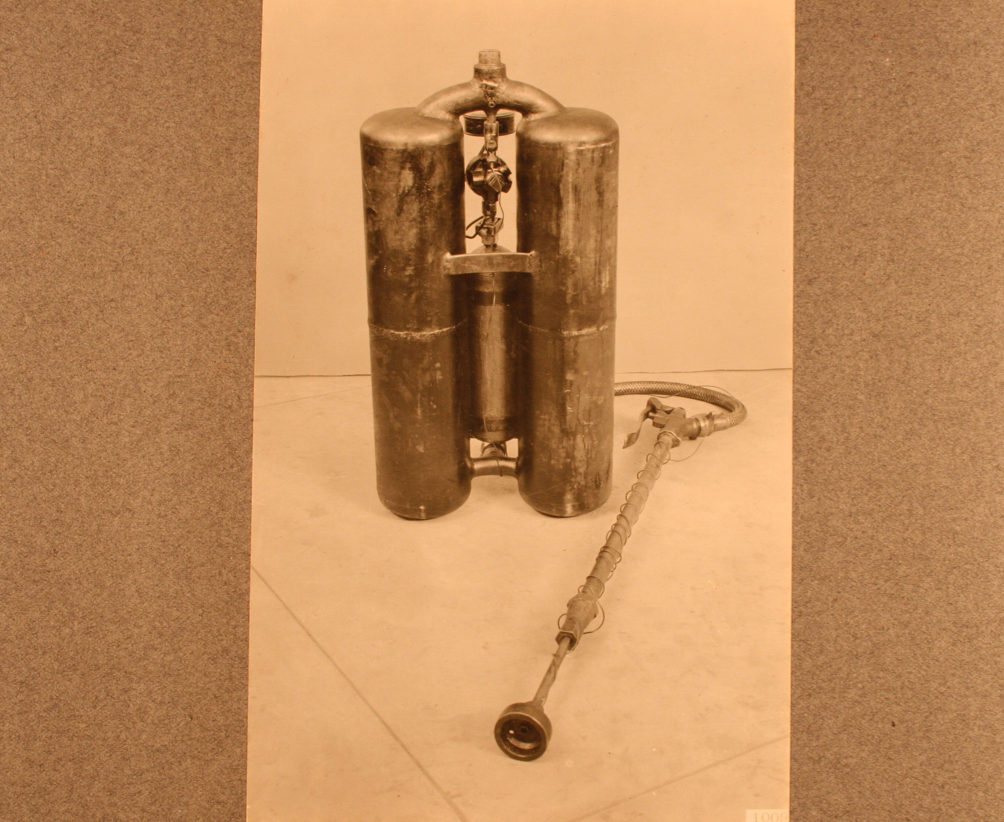 Portable "flaming liquid gun" (flamethrower). (National Archives, photo no. 70-CW-44)
Portable "flaming liquid gun" (flamethrower). (National Archives, photo no. 70-CW-44)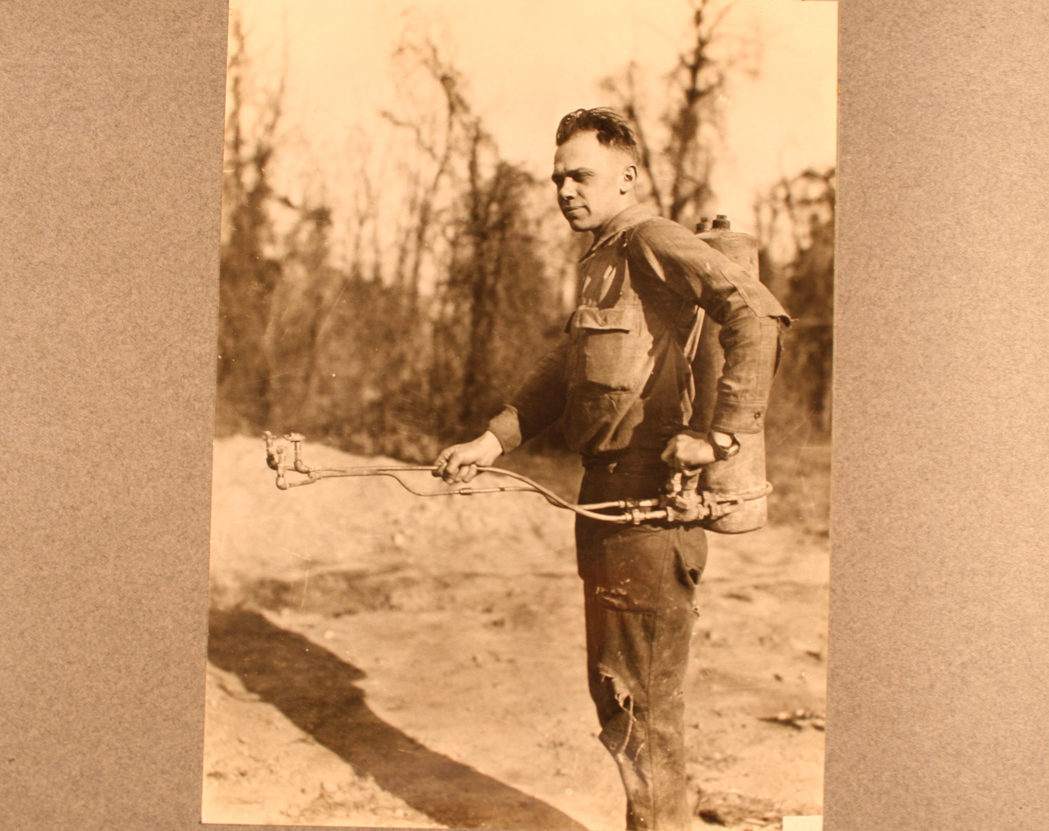 Soldier wearing "smoke knapsack," i.e., portable smoke tank to create smoke screens. (National Archives, photo no. 70-CW-46)
Soldier wearing "smoke knapsack," i.e., portable smoke tank to create smoke screens. (National Archives, photo no. 70-CW-46)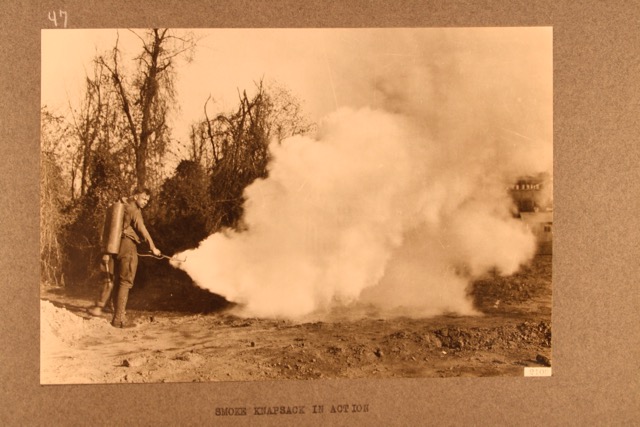 Portable "smoke knapsack" in action. (National Archives, photo no. 70-CW-47)
Portable "smoke knapsack" in action. (National Archives, photo no. 70-CW-47)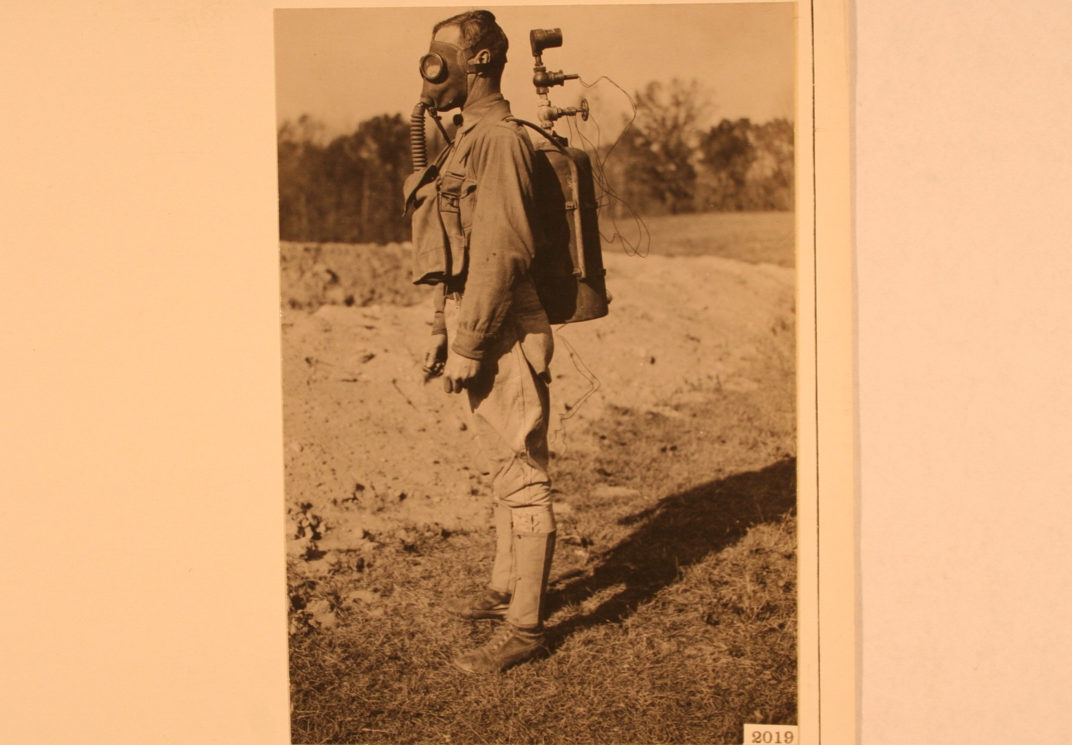 Soldier wearing a mobile gas tank, which were intended to replace the stationary tanks used in cloud or wave gas attacks, like the German chlorine attack in April 1915 which launched gas warfare. The mobile tanks designed to make clouds gas attacks less time- and labor-intensive, were developed too late for use during the war. (National Archives, photo no. 111-SC-54541)
Soldier wearing a mobile gas tank, which were intended to replace the stationary tanks used in cloud or wave gas attacks, like the German chlorine attack in April 1915 which launched gas warfare. The mobile tanks designed to make clouds gas attacks less time- and labor-intensive, were developed too late for use during the war. (National Archives, photo no. 111-SC-54541)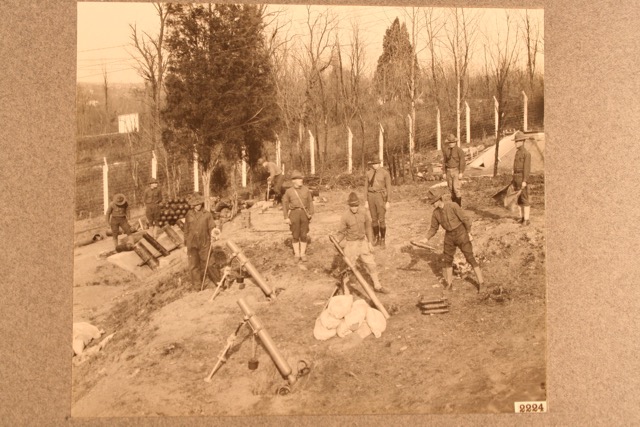 Soldiers in the Research Division at test range at the American University Experiment Station. Stokes mortars with legs, baseplates and sandbags are in foreground. A battery of Livens projectors buried in the ground at an angle are at the left-most side of the photo. (National Archives, photo no. 70-CW-67)
Soldiers in the Research Division at test range at the American University Experiment Station. Stokes mortars with legs, baseplates and sandbags are in foreground. A battery of Livens projectors buried in the ground at an angle are at the left-most side of the photo. (National Archives, photo no. 70-CW-67)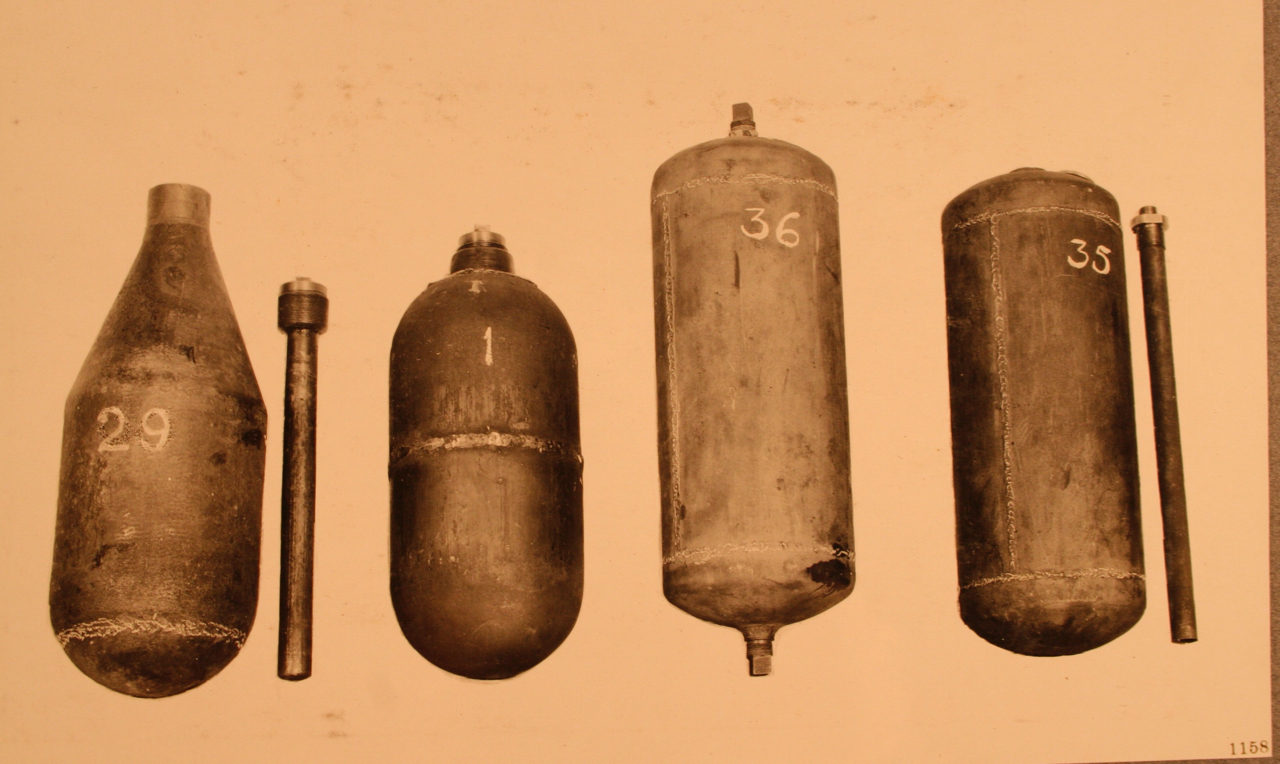 Various models of Liven's drums. National Archives, photo no. 70-CW-77)
Various models of Liven's drums. National Archives, photo no. 70-CW-77)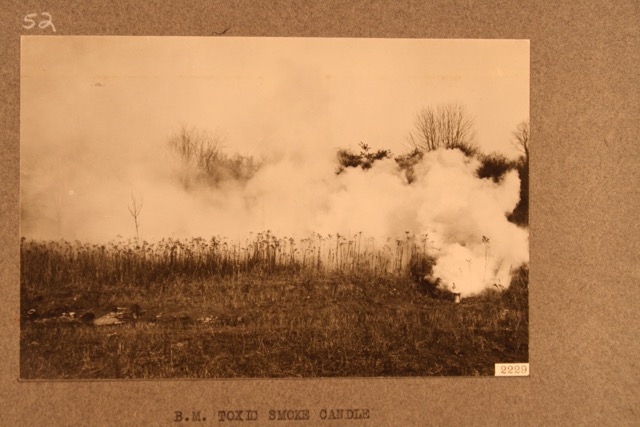 Test of toxic smoke candle. National Archives, photo no. 70-CW-52)
Test of toxic smoke candle. National Archives, photo no. 70-CW-52)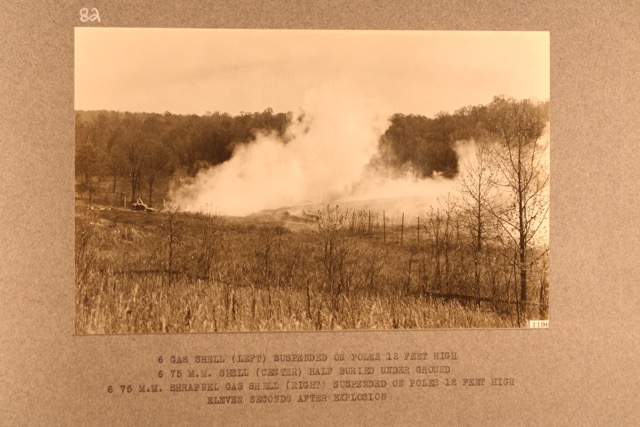 Explosion of gas and shrapnel shells at site of circular test trenches at American University Experiment Station. National Archives, photo no. 70-CW-82)
Explosion of gas and shrapnel shells at site of circular test trenches at American University Experiment Station. National Archives, photo no. 70-CW-82)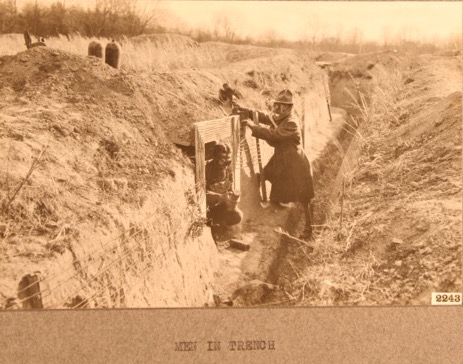 Masked soldiers in one of two circular test trench systems at American University used to determine lethality and behavior of chemical agents under battlefield conditions. Dogs were often used as subjects in the trench tests. Note Liven's shells in top left corner of photo. (National Archives, photo no. 70-CW-66)
Masked soldiers in one of two circular test trench systems at American University used to determine lethality and behavior of chemical agents under battlefield conditions. Dogs were often used as subjects in the trench tests. Note Liven's shells in top left corner of photo. (National Archives, photo no. 70-CW-66)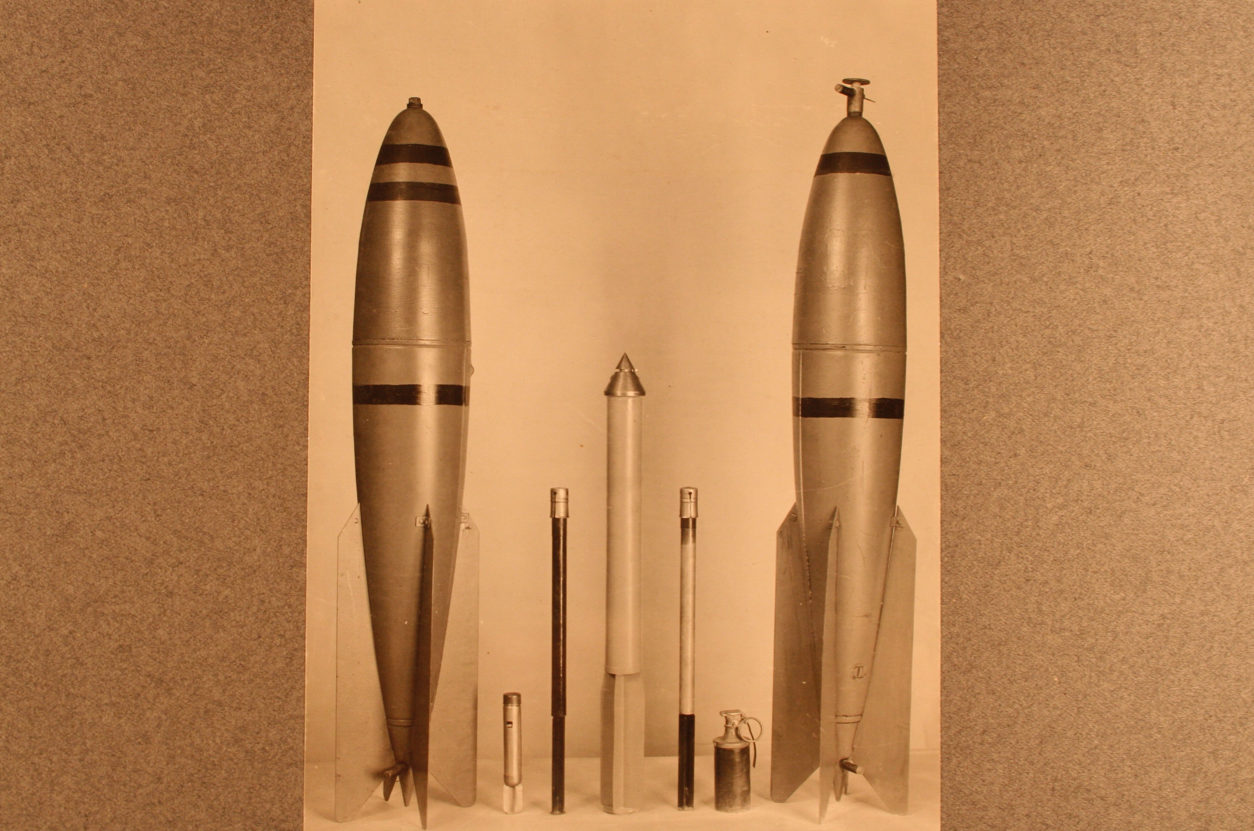 Assorted bombs and incendiary darts. National Archives, photo no. 70-CW-75)
Assorted bombs and incendiary darts. National Archives, photo no. 70-CW-75)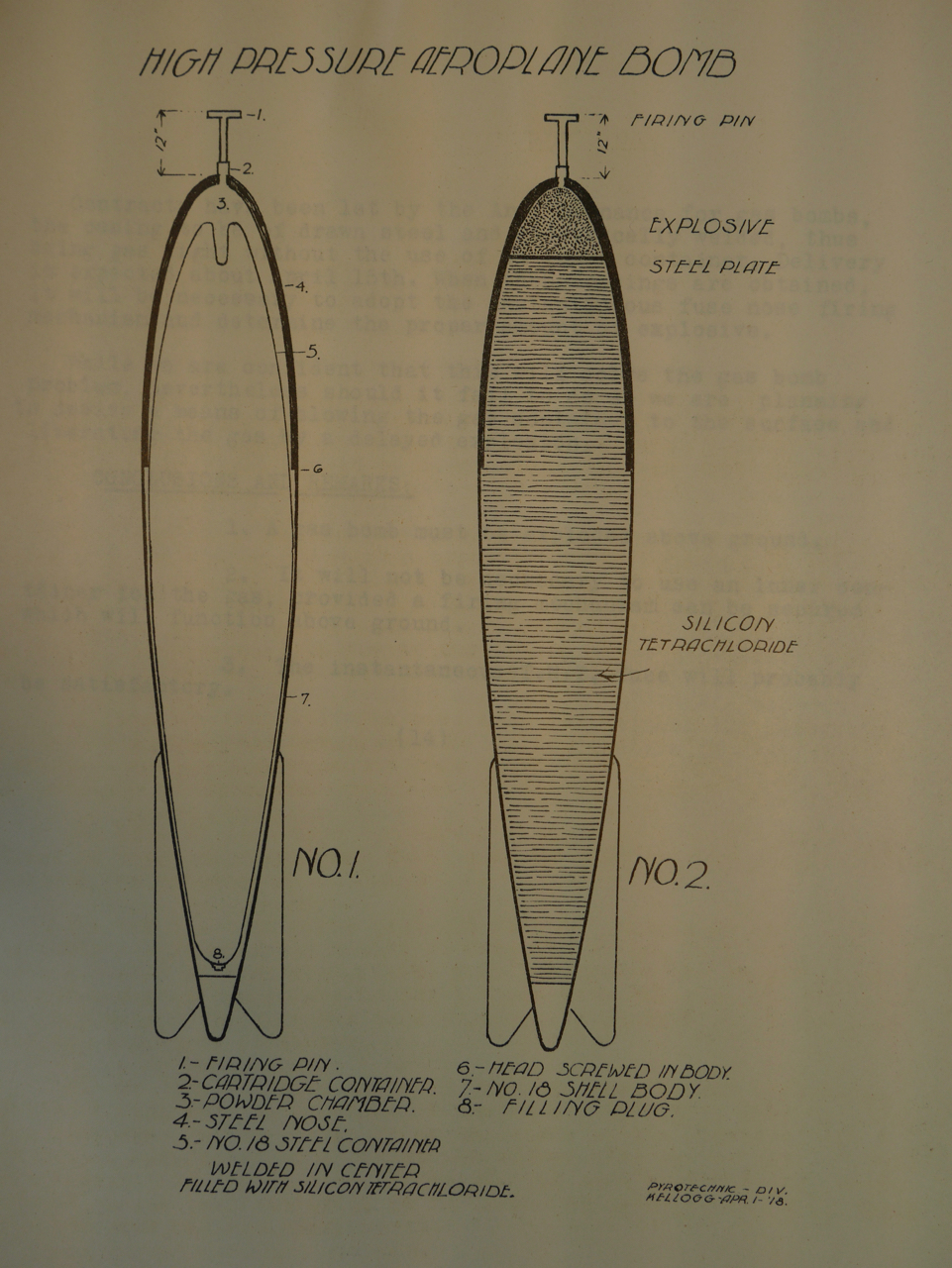 Schematic of an aerial gas bomb from an April 1918 pyrotechnic division report. Bombs tested at Langley Field in Virginia contained a smoke mixture, silicon tetrachloride, for test purposes. After the war, high-ranking officers in the Chemical Warfare Service bragged that it was only due to the war's end that the Germans avoided aerial gas bombardments planned for spring of 1919. (Bureau of Mines Records, RG 70, finding aid A1, entry 47, box 119, National Archives at College Park.)
Schematic of an aerial gas bomb from an April 1918 pyrotechnic division report. Bombs tested at Langley Field in Virginia contained a smoke mixture, silicon tetrachloride, for test purposes. After the war, high-ranking officers in the Chemical Warfare Service bragged that it was only due to the war's end that the Germans avoided aerial gas bombardments planned for spring of 1919. (Bureau of Mines Records, RG 70, finding aid A1, entry 47, box 119, National Archives at College Park.)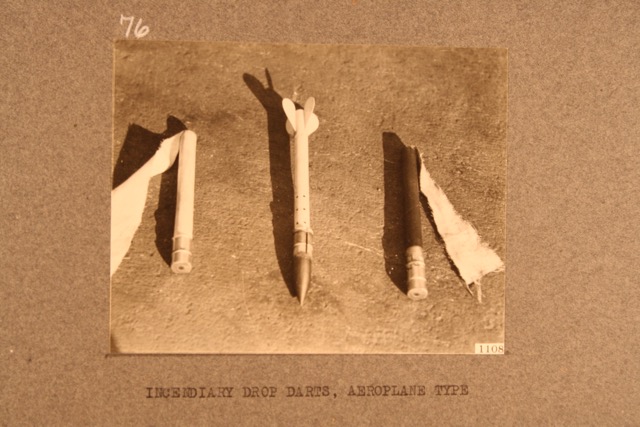 Incendiary darts developed by the Chemical Warfare Service, possibly using the chemical formula Walter Scheele invented to bomb American ships. (National Archives, photo no. 70-CW-76)
Incendiary darts developed by the Chemical Warfare Service, possibly using the chemical formula Walter Scheele invented to bomb American ships. (National Archives, photo no. 70-CW-76)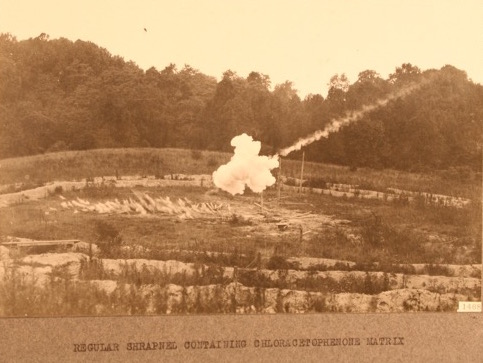 Test with shell containing shrapnel and chloracetophenome, a tear gas, or lachrymator. (National Archives, photo no. 70-CW-90)
Test with shell containing shrapnel and chloracetophenome, a tear gas, or lachrymator. (National Archives, photo no. 70-CW-90)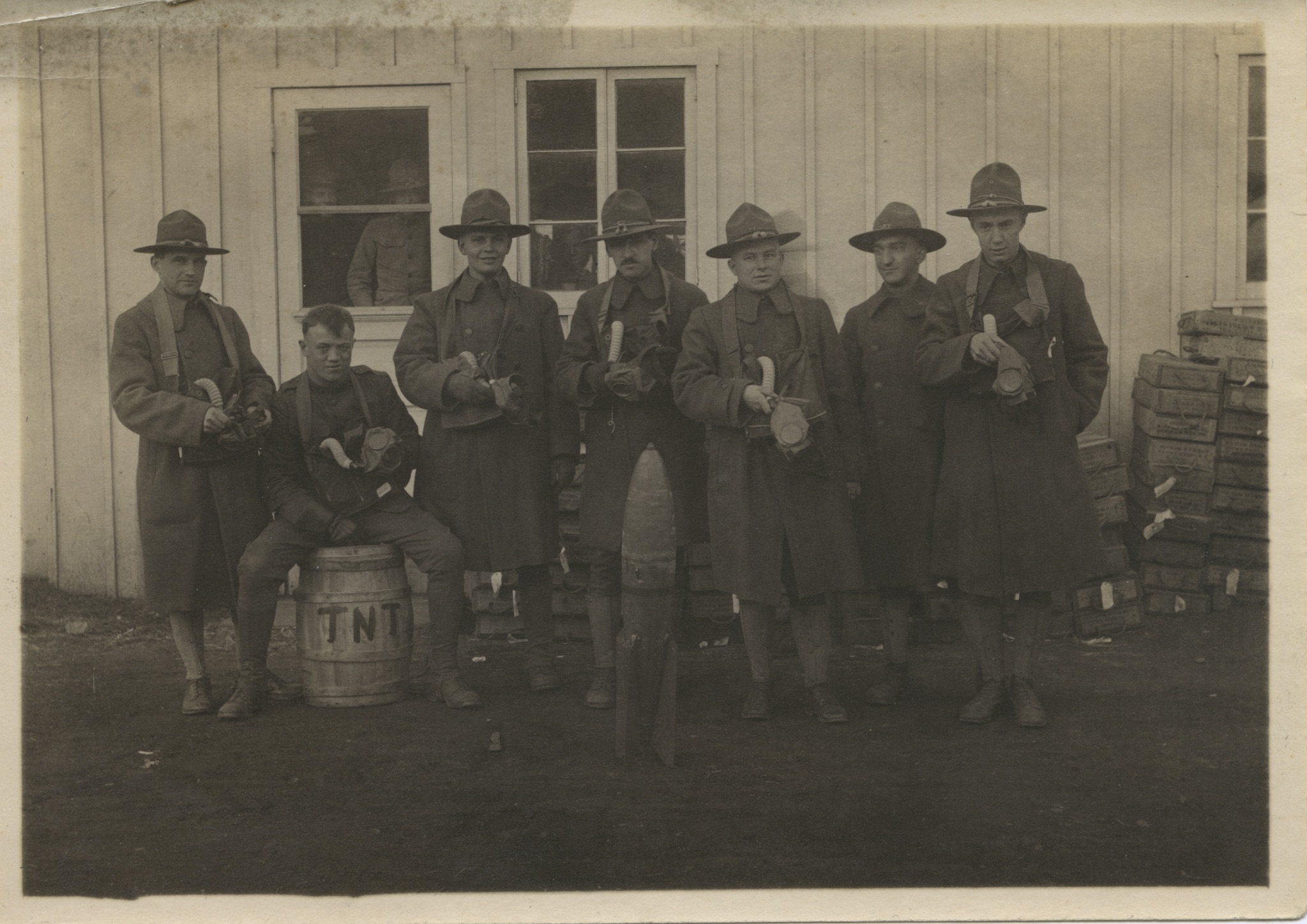 Soldiers posing without masks outside one of the AUES buildings, without masks. (Photo courtesy of the estate of Addie Ruth Maurer Olson.)
Soldiers posing without masks outside one of the AUES buildings, without masks. (Photo courtesy of the estate of Addie Ruth Maurer Olson.)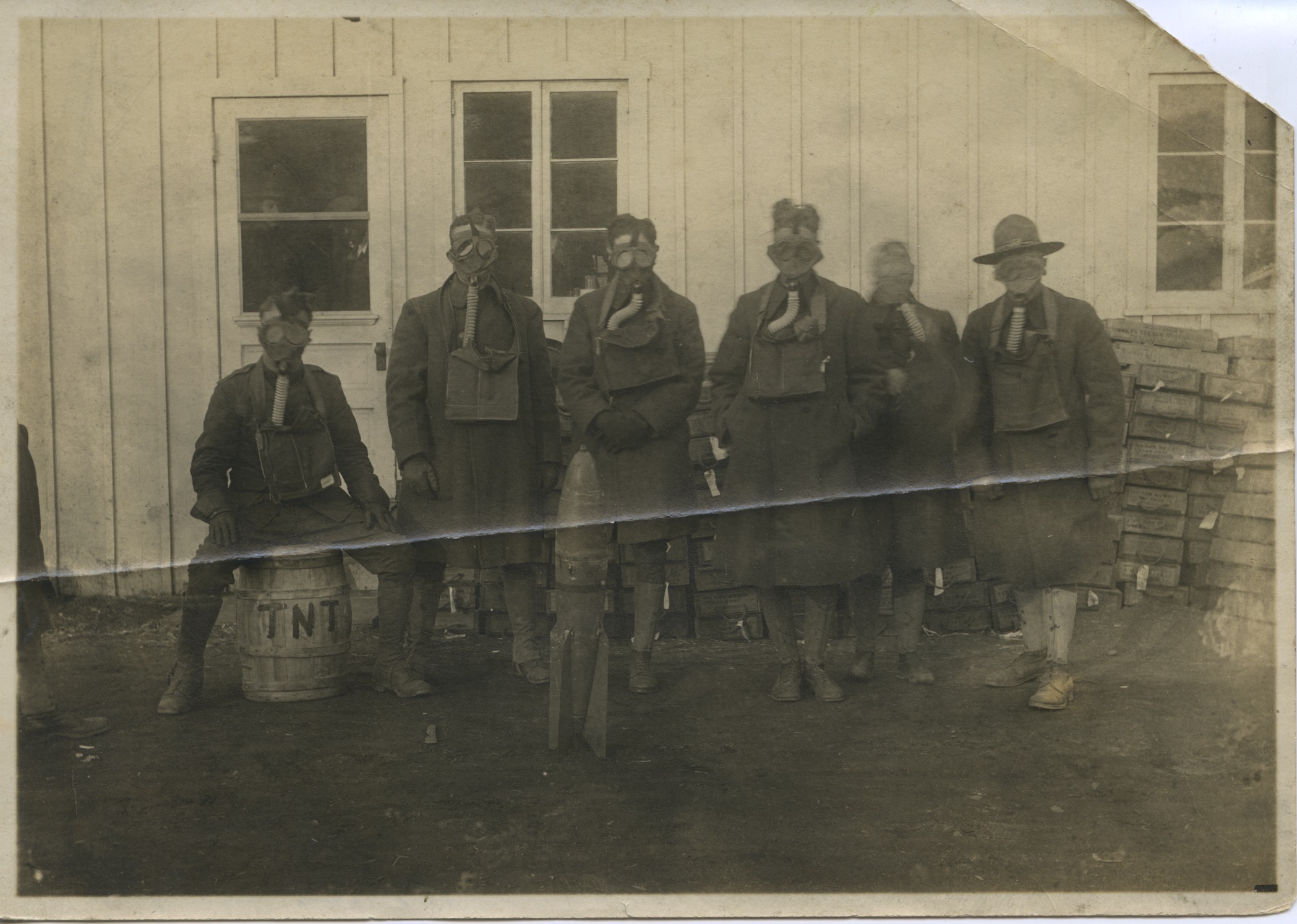 Soldiers posing in masks outside one of the AUES buildings. (Photo courtesy of the estate of Addie Ruth Maurer Olson.)
Soldiers posing in masks outside one of the AUES buildings. (Photo courtesy of the estate of Addie Ruth Maurer Olson.)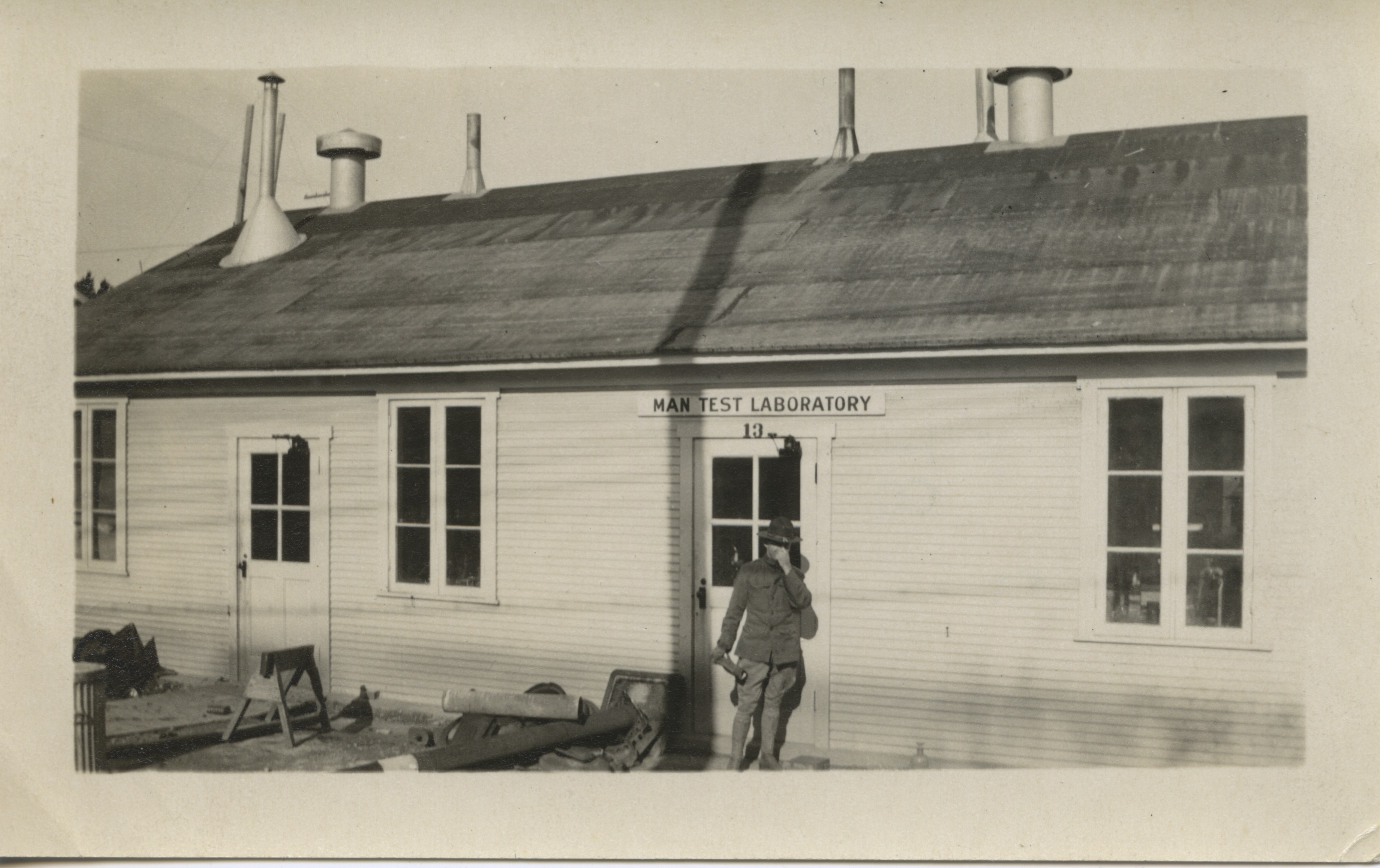 Photo of the outside of the man test laboratory. (Photo courtesy of the estate of Addie Ruth Maurer Olson.)
Photo of the outside of the man test laboratory. (Photo courtesy of the estate of Addie Ruth Maurer Olson.)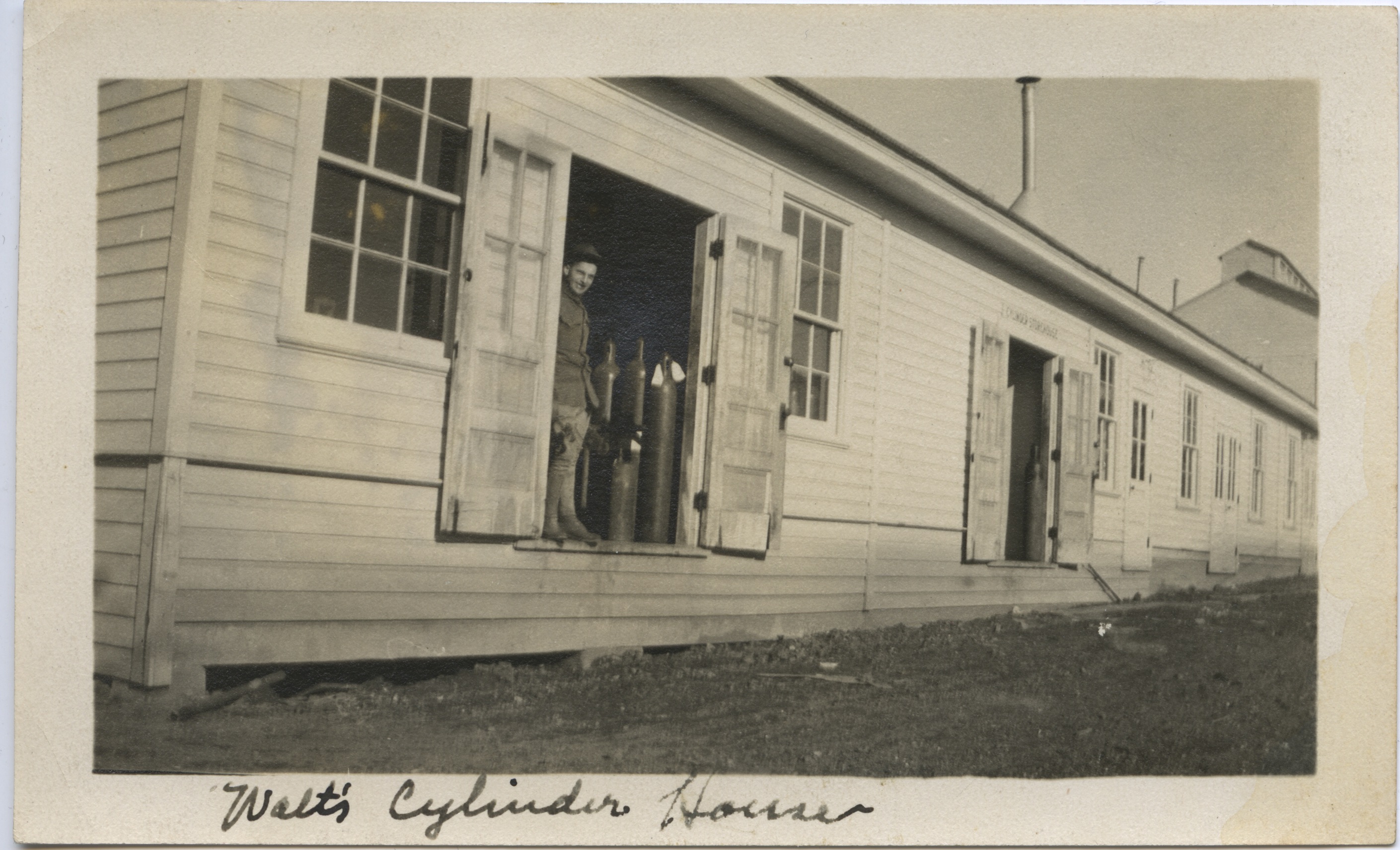 (Photo courtesy of the estate of Addie Ruth Maurer Olson.)
(Photo courtesy of the estate of Addie Ruth Maurer Olson.)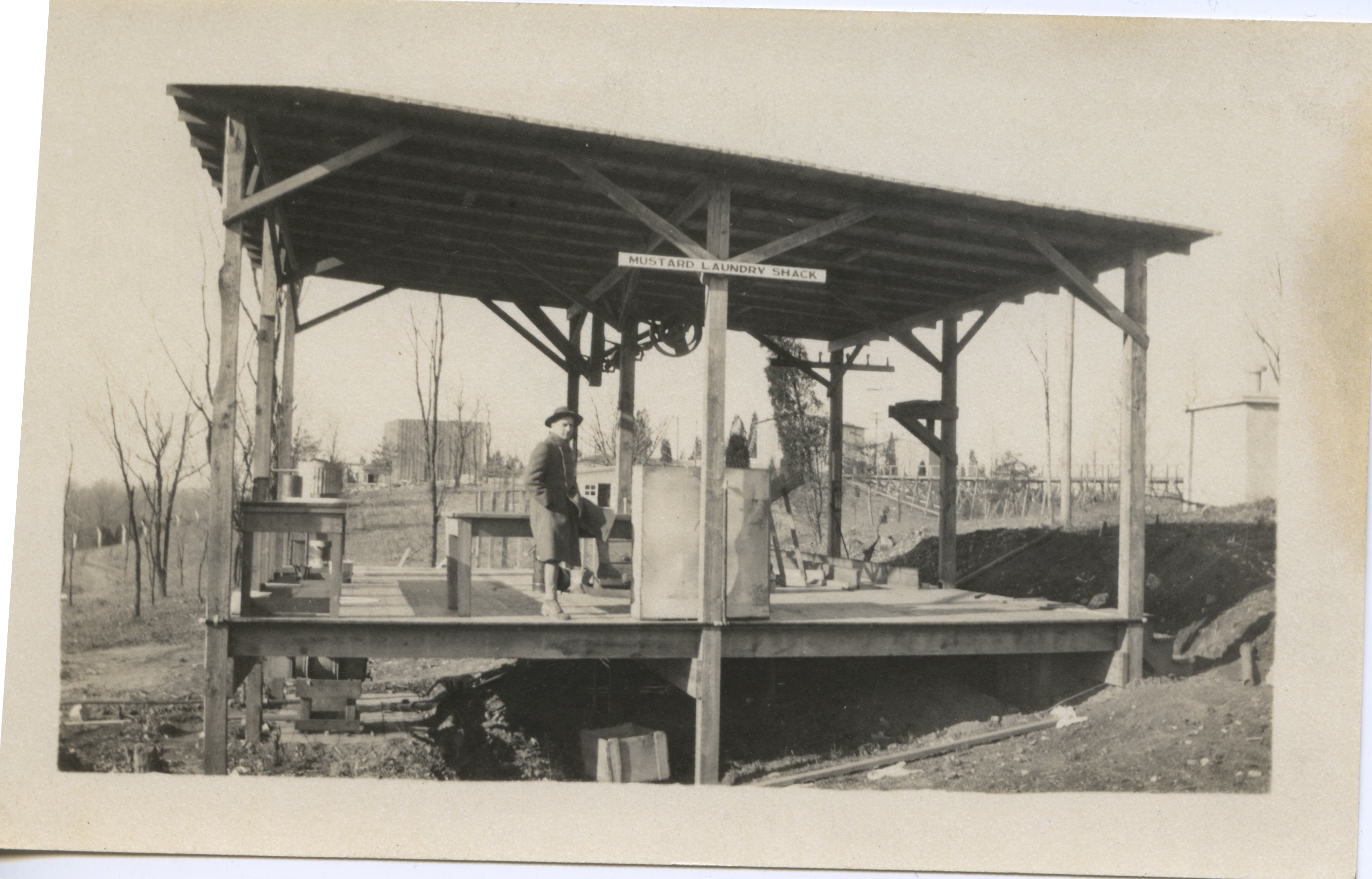 (Photo courtesy of the estate of Addie Ruth Maurer Olson.)
(Photo courtesy of the estate of Addie Ruth Maurer Olson.)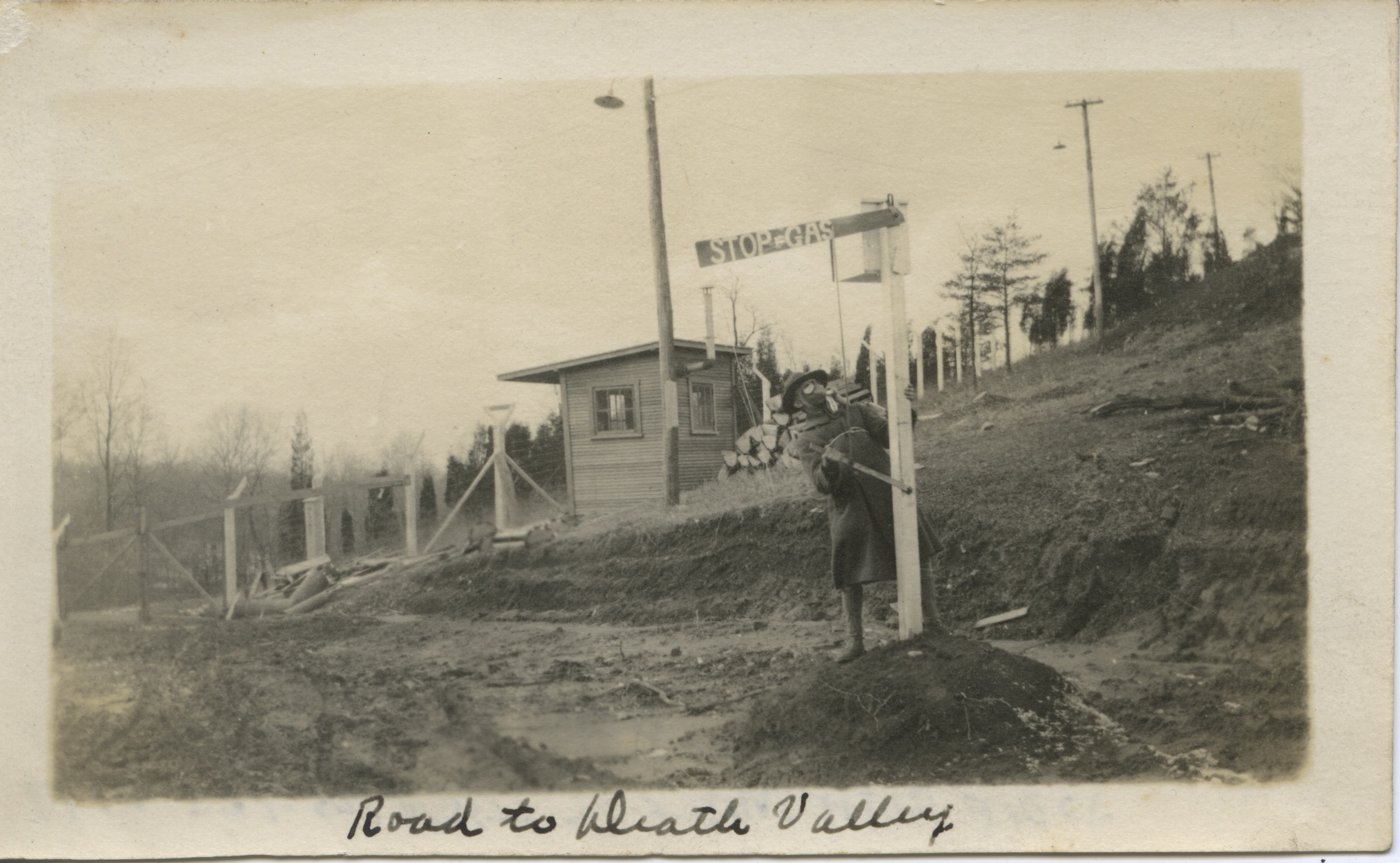 View of a soldier, probably Charles William Maurer, with gas warning sign at the periphery of the American University Experiment Station. (Photo courtesy of estate of Addie Ruth Maurer Olson)
View of a soldier, probably Charles William Maurer, with gas warning sign at the periphery of the American University Experiment Station. (Photo courtesy of estate of Addie Ruth Maurer Olson)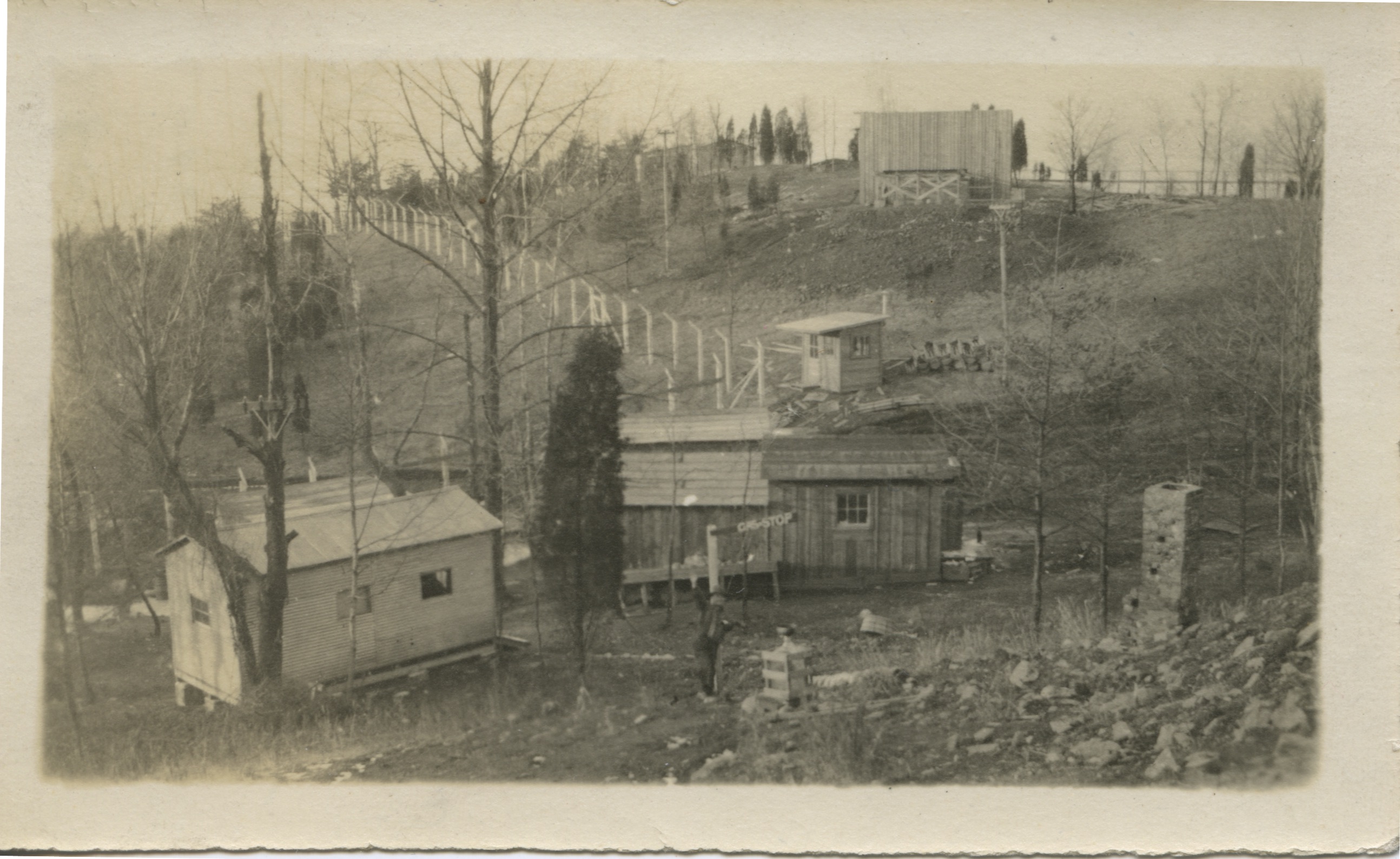 Back of photo reads "Stop! Phosgene loose again! Death Valley from the edge. It is surrounded by these signs. Another blown up shack in lower corner." Explosion debris may be result of blast that released lewisite cloud in August 1918 that resulted in injuries to former Senator Nathan Bay Scott. (Photo courtesy of estate of Addie Ruth Maurer Olson)
Back of photo reads "Stop! Phosgene loose again! Death Valley from the edge. It is surrounded by these signs. Another blown up shack in lower corner." Explosion debris may be result of blast that released lewisite cloud in August 1918 that resulted in injuries to former Senator Nathan Bay Scott. (Photo courtesy of estate of Addie Ruth Maurer Olson)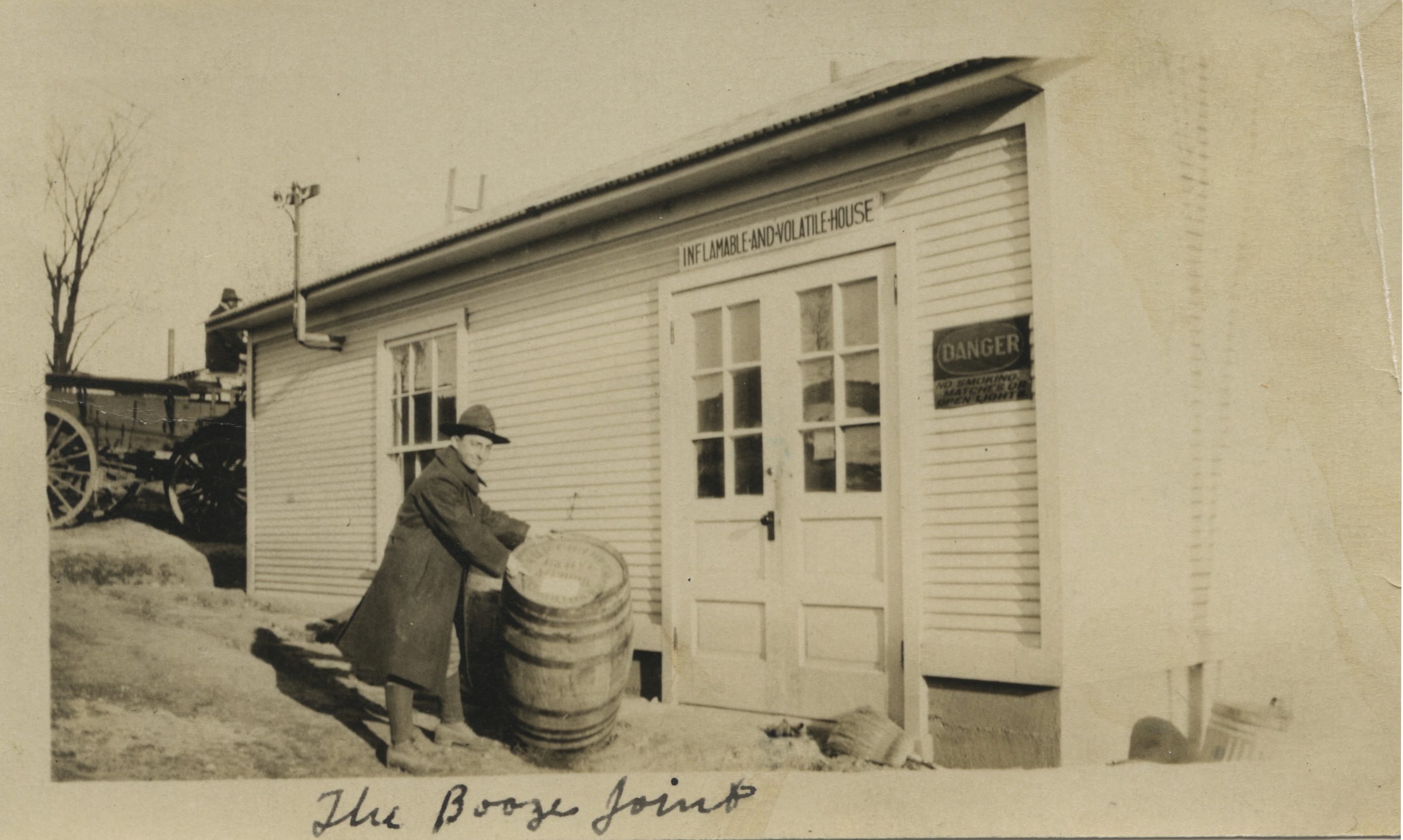 Photo of Charles William Maurer. Back of photo reads "National prohibition doesn't affect me. My headquarters for several months." (Photo courtesy of estate of Addie Ruth Maurer Olson)
Photo of Charles William Maurer. Back of photo reads "National prohibition doesn't affect me. My headquarters for several months." (Photo courtesy of estate of Addie Ruth Maurer Olson)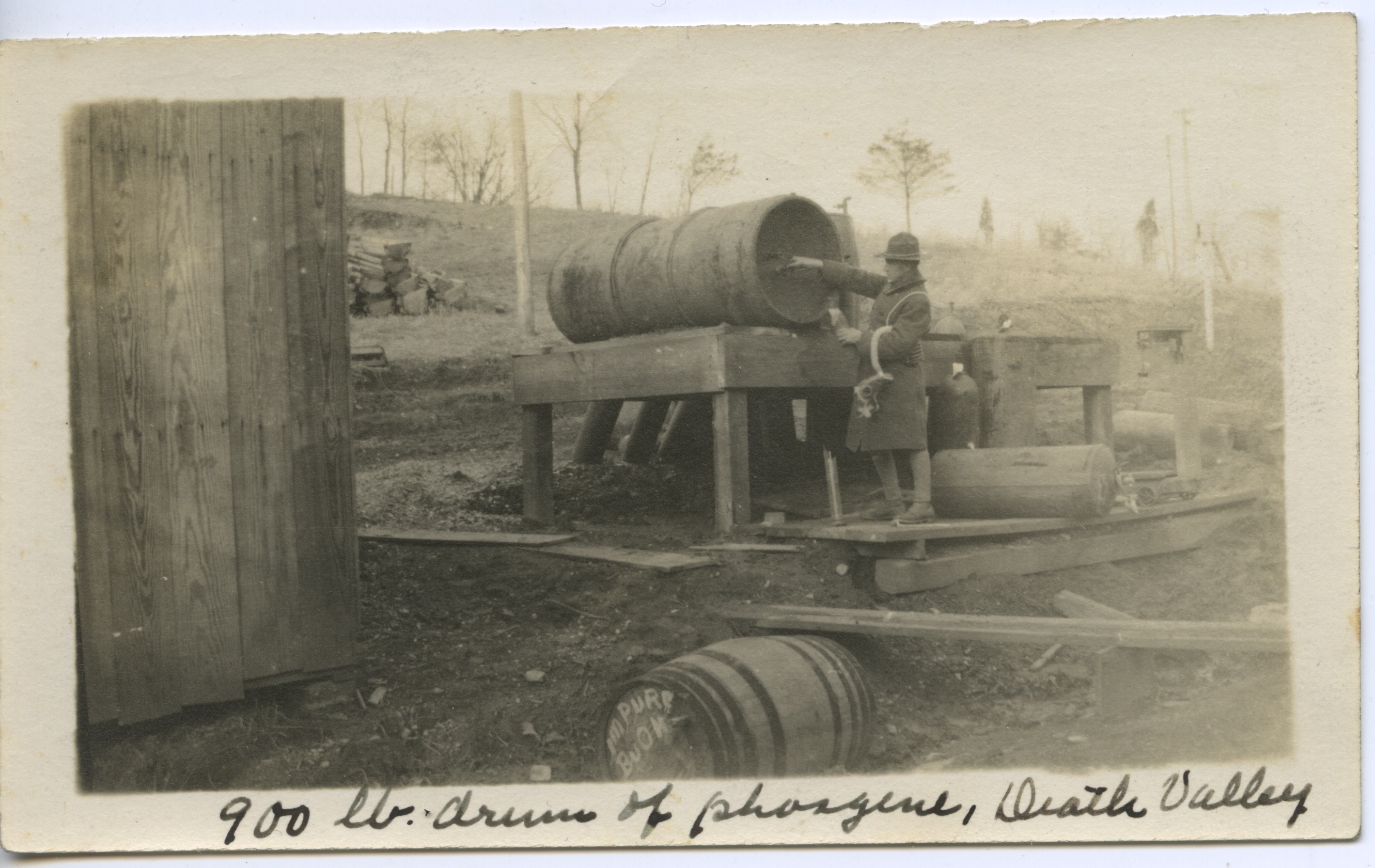 Drum of phosgene on the grounds of American University Experiment Station. (Photo courtesy of estate of Addie Ruth Maurer Olson)
Drum of phosgene on the grounds of American University Experiment Station. (Photo courtesy of estate of Addie Ruth Maurer Olson)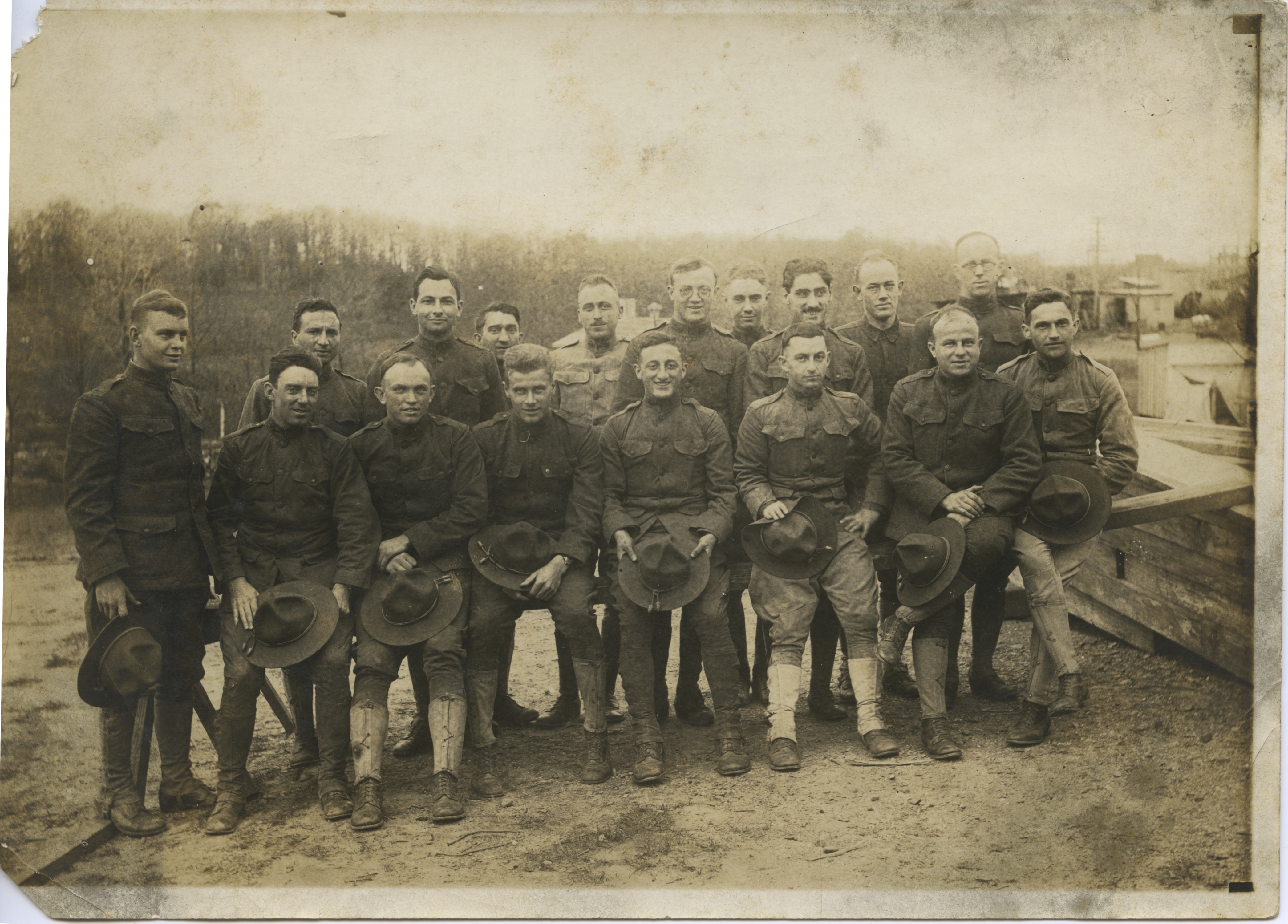 Photos of the soldiers and chemists at the American University Experiment Station. Charles William Maurer is the third soldier from the right in the front row. (Photo courtesy of the estate of Addie Ruth Maurer Olson._
Photos of the soldiers and chemists at the American University Experiment Station. Charles William Maurer is the third soldier from the right in the front row. (Photo courtesy of the estate of Addie Ruth Maurer Olson._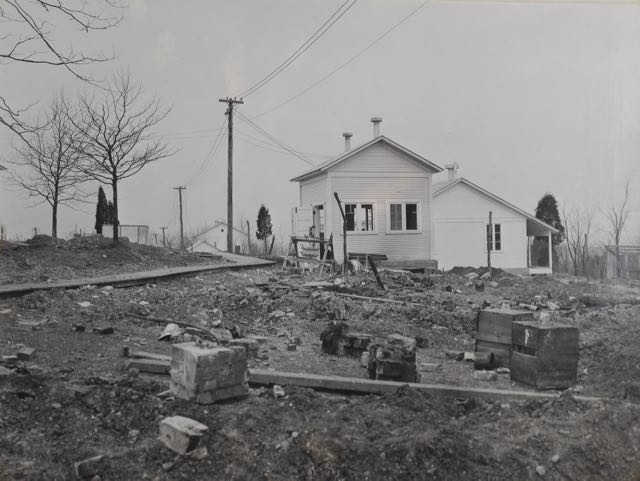 Aftermath of a Feb. 1918 explosion in which several soldiers and officers were injured at American University Experiment Station. (National Archives, Record Group 70, Bureau of Mines)
Aftermath of a Feb. 1918 explosion in which several soldiers and officers were injured at American University Experiment Station. (National Archives, Record Group 70, Bureau of Mines)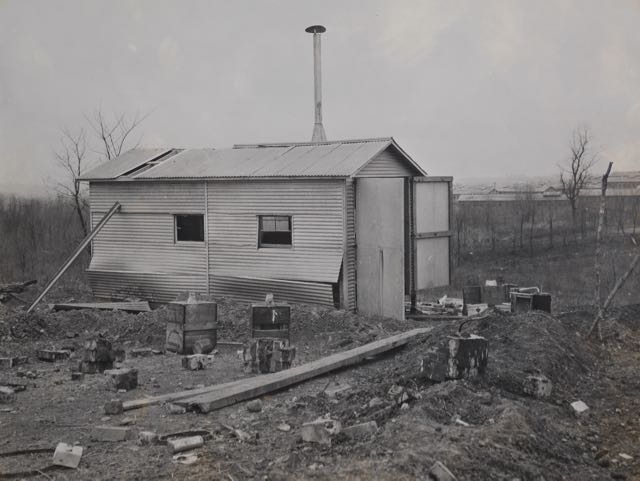 Aftermath of a Feb. 1918 explosion in which several soldiers and officers were injured at American University Experiment Station. (National Archives, Record Group 70, Bureau of Mines)
Aftermath of a Feb. 1918 explosion in which several soldiers and officers were injured at American University Experiment Station. (National Archives, Record Group 70, Bureau of Mines)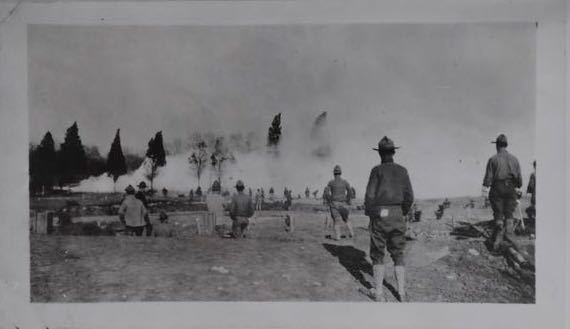 Future gas officers training at American University in fall of 1917. (Photo courtesy of the U.S. Army Chemical Corps Museum)
Future gas officers training at American University in fall of 1917. (Photo courtesy of the U.S. Army Chemical Corps Museum)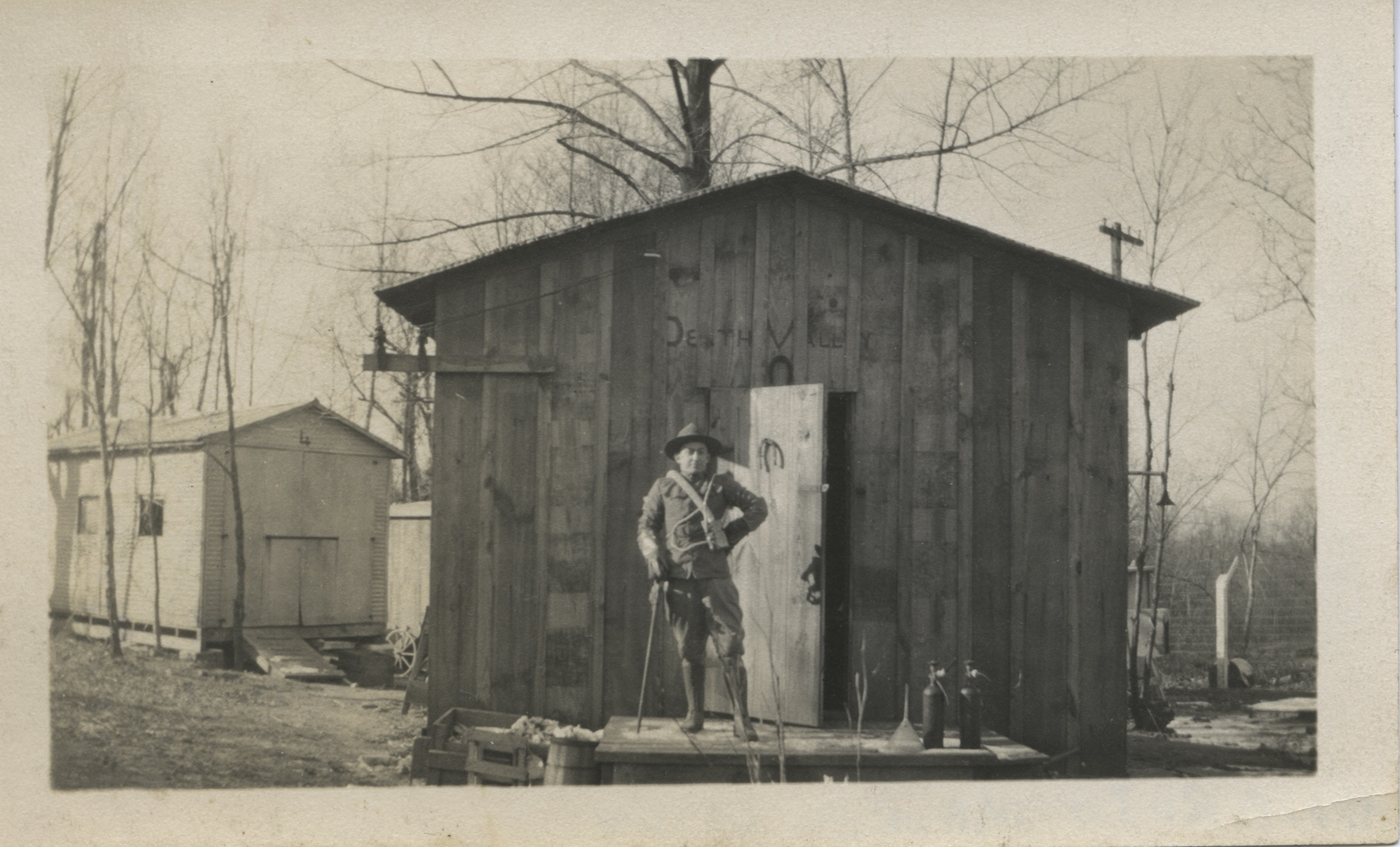 Charles William Maurer, wearing gloves to protect against mustard, posing outside the shell-filling shack he called "my office." The inscription on the back of the photo said the shack was filled with mustard and lewisite. (Photo courtesy of estate of Addie Ruth Maurer Olson)
Charles William Maurer, wearing gloves to protect against mustard, posing outside the shell-filling shack he called "my office." The inscription on the back of the photo said the shack was filled with mustard and lewisite. (Photo courtesy of estate of Addie Ruth Maurer Olson)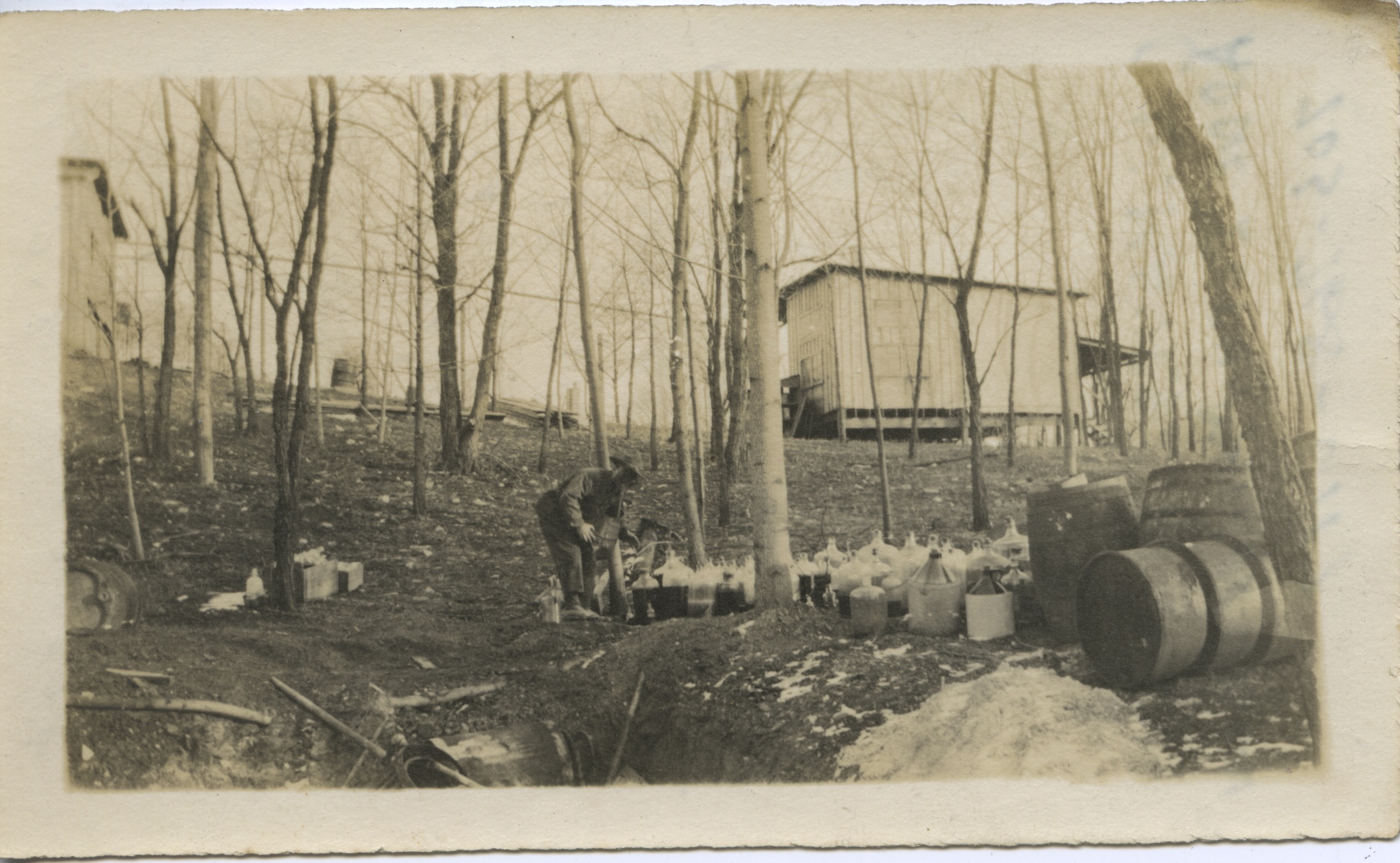 A soldier, most likely Charles William Maurer, posted at the lip of the pit called "Hades." The back of the photo reads: "The Pit. The most feared and respected place on the grounds. The bottles are full of mustard, to be destroyed here. In Death Valley. The hole called Hades. You know me?" The photo helped pinpoint the location of the pit, which the Army determined was under the back porch of a luxury house built on the property. The house was razed in 2012, and cleanup was still ongoing in fall of 2017. (Photo courtesy of the estate of Addie Ruth Maurer Olson.)
A soldier, most likely Charles William Maurer, posted at the lip of the pit called "Hades." The back of the photo reads: "The Pit. The most feared and respected place on the grounds. The bottles are full of mustard, to be destroyed here. In Death Valley. The hole called Hades. You know me?" The photo helped pinpoint the location of the pit, which the Army determined was under the back porch of a luxury house built on the property. The house was razed in 2012, and cleanup was still ongoing in fall of 2017. (Photo courtesy of the estate of Addie Ruth Maurer Olson.)
Author of Hellfire Boys
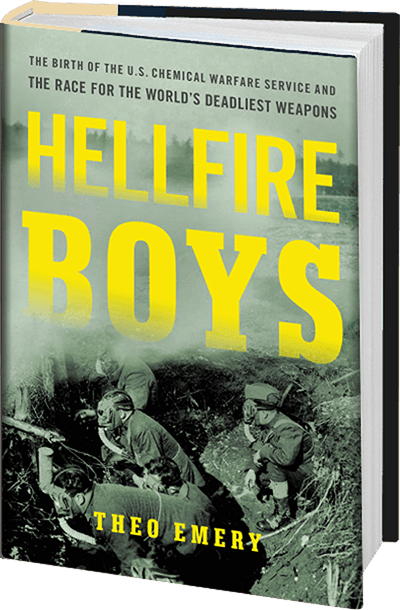
"Though squarely a crackling history, “Hellfire Boys” is also a relevant primer on the past 100 years and on a kind of total warmaking that continues to haunt us — sometimes from another hemisphere, sometimes in our own back yard....Emery’s reporting is vast and meticulous, and his storytelling is focused and clean."
―WASHINGTON POST
2017-12-29T03:11:48+00:00
―WASHINGTON POST
https://www.theoemery.com/testimonials/washington-post/
"Moving crisply between stateside turf wars and battlefront combat, this well-written and well-researched slice of history will appeal to virtually any history or war buff." (Starred review)
―LIBRARY JOURNAL
2017-11-03T23:34:11+00:00
―LIBRARY JOURNAL
https://www.theoemery.com/testimonials/library-journal/
"Refusing to allow our modern revulsion of chemical weapons (however well-founded) to shape his extraordinary narrative, Emery—like all good historians—is determined to let the era of his subject speak for itself."
―HAMPTON SIDES, New York Times bestselling author of In the Kingdom of Ice, Ghost Soldiers, Hellhound on His Trail, and Blood and Thunder
2017-10-09T20:38:16+00:00
―HAMPTON SIDES, New York Times bestselling author of In the Kingdom of Ice, Ghost Soldiers, Hellhound on His Trail, and Blood and Thunder
https://www.theoemery.com/testimonials/hampton-sides/
"A fascinating and deeply researched account of how America reinvented its military—and itself—in its first modern global war. Theo Emery combines science, history, and character-driven drama to illuminate some of the darkest aspects of our national past."
―BEVERLY GAGE, author of The Day Wall Street Exploded and Professor of History and American Studies at Yale University
2017-10-09T20:37:06+00:00
―BEVERLY GAGE, author of The Day Wall Street Exploded and Professor of History and American Studies at Yale University
https://www.theoemery.com/testimonials/beverly-gage/
"Even military buffs will learn from this intensely researched, often unnerving account.... Readers will share Emery's lack of nostalgia for this half-forgotten weapon, but they will admire this satisfying combination of technical background, battlefield fireworks, biographies of colorful major figures, and personal anecdotes from individual soldiers."
―KIRKUS
2017-10-09T20:36:29+00:00
―KIRKUS
https://www.theoemery.com/testimonials/kirkus/
"Journalist Emery offers a useful and absorbing reminder that, a century earlier, it was a different weapon of mass destruction that terrified both soldiers and civilians... This is a timely and often unsettling examination of a previously well-hidden government program."
―BOOKLIST
2017-10-09T20:36:05+00:00
―BOOKLIST
https://www.theoemery.com/testimonials/booklist/